1987 Tour de France
74th edition: july 1 to july 26 , 1987, results, stages with running gc, map, photos, video and history.
1986 Tour | 1988 Tour | Tour de France Database | 1987 Tour Quick Facts | 1987 Tour de France Final GC | Stage results with running GC | The Story of the 1987 Tour de France | Owen Mulholland's Story of the 87 Tour | Video
1987 Tour de France map

Plato's dialogue Phaedo is available as an audiobook here .
1987 Tour quick facts:
4,321.1 kilometers, average Speed: 36.645 km/hr
Eight different owners of the Yellow Jersey, nine changes of leader.
207 starters, 135 finishers.
From stage 19, where Roche took the lead after Jean-François Bernard punctured, the 1987 Tour was a nail-biter with Pedro Delgado and Stephen Roche being well-balanced opponents.
Winner Roche had already won the Giro that year and went on to become World Champion.
Only Eddy Merckx in 1974 had performed that triple. No one has since.
1987 Tour de France complete final General Classification
- Pedro Delgado (PDM) @ 40sec
- Jean François Bernard (Toshiba) @ 2min 13sec
- Charly Mottet (Système U) @ 6min 40sec
- Luis Herrera (Cafe de Colombia) @ 9min 32sec
- Fabio Parra (Cafe de Colombia) @ 16min 53sec
- Laurent Fignon (Système U) @ 18min 24sec
- Anselmo Fuerte (BH) @ 18min 33sec
- Raul Alcala (7-Eleven) @ 21min 49sec
- Marino Lajaretta (Caja Rural) @ 26min 13sec
- Claude Criquielion (Hitachi-Marc) @ 30min 32sec
- Federico Echave (BH) @ 31min 6sec
- Martin Alonso (Cafe de Colombia) @ 36min 55sec
- Gerhard Zadrobilek (Supermercati Brianzoli) @ 40min 35sec
- Luciano Loro (Del Tongo) @ 43min 52sec
- Andrew Hampsten (7-Eleven) @ 44min 7sec
- Jean-René Bernaudeau (Fagor) @ 47min 16sec
- Rafael Acevedo (Cafe de Colombia) @ 50min 33sec
- Robert Millar (Panasonic) @ 50min 47sec
- Denis Roux (Z) @ 52min 13sec
- Erik Breukink (Panasonic) @ 53min 35sec
- Pedro Muñoz (Fagor) @ 59min 27sec
- Eric Caritoux (Fagor) @ 1hr 5min 33sec
- Omar Pablo Hernandez (Ryalcao-Postobon) @ 1hr 14min 10sec
- Eduardo Chozas (Teka) @ 1hr 14min 59sec
- Beat Breu (Joker) @ 1hr 20min 2sec
- Phil Anderson (Panasonic) @ 1hr 20min 43sec
- Gilles Sanders (KAS) @ 1hr 20min 57sec
- Jesper Skibby (Roland-Skala) @ 1hr 21min 13sec
- Eddy Schepers (Carrera) @ 1hr 22min 13sec
- Guido Van Calster (BH) @ 1hr 26min 47sec
- Gilles Mas (RM) @ 1hr 26min 48sec
- Jean-Claude Bagot (Fagor) @ 1hr 27min 16sec
- Martial Gayant (Système U) @ 1hr 29min 17sec
- José Salvador Sanchis (Caja Rural) @ 1hr 30min 6sec
- Juan Carlos Castillo (Cafe de Colombia) @ 1hr 33min 1sec
- Bruno Cornillet (Z) @ 1hr 33min 37sec
- Robert Forest (Fagor) @ 1hr 35min 4sec
- Dag Otto Lauritzen (7-Eleven) @ 1hr 35min 52sec
- Christophe Lavainne (Système U) @ 1hr 36min 12sec
- Jokin Mujika (Caja Rural) @ 1hr 36min 15sec
- Jérôme Simon (Z) @ 1hr 36min 25sec
- José Luis Laguia (PDM) @ 1hr 38min 27sec
- Marco Antonio Leon (Cafe de Colombia) @ 1hr 29min 40sec
- Peter Stevenhaagen (PDM) @ 1hr 41min 50sec
- Julio-César Cadena (Cafe de Colombia) @ 1hr 44min 11sec
- Marc Madiot (Système U) @ 1hr 46min 46sec
- Gert-Jan Theunisse (PDM) @ 1hr 53min 5sec
- Rolf Gölz (Superconfex) @ 1hr 54min 24sec
- Jean-Claude Leclercq (Toshiba) @ 1hr 54min 40sec
- Fabian Fuchs (Hitachi-Marc) @ 1hr 55min 11sec
- Roque de la Cruz (Caja Rural) @ 1hr 55min 36sec
- Pascal Simon (Z) @ 1hr 58min 19sec
- Dominique Garde (Toshiba) @ 1hr 59min 4sec
- Silvano Contini (Del Tongo) @ 1hr 59min 15sec
- Eric Van Lancker (Panasonic) @ 1hr 59min 46sec
- Bernard Gavillet (Système U) @ 2hr 0min 18sec
- Enrique Aja (Teka) @ 2hr 0min 48sec
- Charly Berard (Toshiba) @ 2hr 1min 31sec
- Bernard Vallet (RMO) @ 2hr 4min 39sec
- Guy Nulens (Panasonic) @ 2hr 5min 46sec
- Kim Andersen (Toshiba) @ 2hr 5min 48sec
- Nestor Oswaldo Mora (Ryalcao-Postobon) @ 2hr 6min 7sec
- Acácio da Silva (KAS) @ 2hr 13min 27sec
- Martin Early (Fagor) @ 2hr 14min 22sec
- Philippe Bouvatier (BH) @ 2hr 15min 50sec
- Pascal Poisson (Système U) @ 2hr 16min 5sec
- Jørgen V. Pedersen (Carrera) @ 2hr 16min 45sec
- Argemiro Bohoquez (Cafe de Colombia) @ 2hr 18min 55sec
- Adrian Timmis (ANC-Halfords) @ 2hr 19min 21sec
- Jos Haex (Hitachi-Marc) @ 2hr 20min 49sec
- Régis Clère (Teka) @ 2hr 21min 21sec
- Yvon Madiot (Système U) @ 2hr 21min 57sec
- Steve Bauer (Toshiba) @ 2hr 24min 41sec
- François Lemarchand (Fagor) @ 2hr 26min 57sec
- Jean-Philippe Vandenbrande (Hitachi-Marc) @ 2hr 28min 58sec
- Jean-François Rault (RMO) @ 2hr 30min 6sec
- Jesus Rodriguez (Teka) @ 2hr 30min 8sec
- Marc Gomez (Reynolds) @ 2hr 31min 0sec
- Gilbert Duclos-Lassalle (Z) @ 2hr 31min 21sec
- Alessandro Pozzi (Del Tongo) @ 2hr 31min 48sec
- Ron Kiefel (7-Eleven) @ 2hr 33min 34sec
- Julián Gorospe (Reynolds) @ 2hr 36min 11sec
- Teun van Vliet (Panasonic) @ 2hr 39min 11sec
- Erich Mächler (Carrera) @ 2hr 40min 1sec
- Alfred Achermann (KAS) @ 2hr 41min 36sec
- Thierry Marie (Système U) @ 2hr 42min 1sec
- Jeff Pierce (7-Eleven) @ 2hr 42min 22sec
- Gerrie Knetemann (PDM) @ 2hr 43min 7sec
- Raimund Dietzen (Teka) @ 2hr 43min 19sec
- Theo De Rooy (Panasonic) @ 2hr 43min 19sec
- Frédéric Brun (Z) @ 2hr 44min 32sec
- Stefan Morjean (Hitachi-Marc) @ 2hr 47min 55sec
- Malcom Eliotti (ANC-Halfords) @ 2hr 48min 39sec
- Henk Lubberding (Panasonic) @ 2hr 51min 8sec
- Ludo Peeters (Superconfex) @ 2hr 52min 45sec
- Miguel Indurain (Reynolds) @ 2hr 53min 11sec
- Jonathan Boyer (7-Eleven) @ 2hr 53min 47sec
- Jörg Müller (PDM) @ 2hr 54min 4sec
- Celestino Prieto (KAS) @ 2hr 55min 2sec
- Cristóbal Pérez (Cafe de Colombia) @ 2hr 58min 20sec
- Giancarlo Perini (Carrera) @ 2hr 58min 38sec
- Kvetoslav Palov (ANC-Halfords) @ 2hr 59min 4sec
- Luc Roosen (Superconfex) @ 2hr 59min 30sec
- Adrie van der Poel (PDM) @ 2hr 59min 44sec
- Peter Hilse (Teka) @ 3hr 1min 26sec
- Roland Le Clerc (Caja Rural) @ 3hr 3min 4sec
- Jesús Hernández (Reynolds) @ 3hr 4min 9sec
- Massimo Ghirotto (Carrera) @ 3hr 4min 57sec
- Brian Holm (Roland-Skala) @ 3hr 8min 13sec
- Davide Cassani (Carrera) @ 3hr 10min 33sec
- Guido Winterberg (Toshiba) @ 3hr 12min 26sec
- José Luis Navarro (BH) @ 3hr 12min 38sec
- Pascal Jules (Caja Rural) @ 3hr 12min 47sec
- Michel Dernies (Joker) @ 3hr 12min 53sec
- Rudy Patry (Roland-Skala) @ 3hr 14min 45sec
- Francisco-José Antequera (BH) @ 3hr 16min 13sec
- Manuel Jorge Dominguez (BH) @ 3hr 16min 38sec
- Guido Bontempi (Carrera) @ 3hr 16min 41sec
- Maurizio Piovani (Del Tongo) @ 3hr 18min 57sec
- Jan Wynants (Hitachi-Marc) @ 3hr 19min 19sec
- Herman Frison (Roland-Skala) @ 3hr 19min 37sec
- André Chappuis (RMO) @ 3hr 21min 18sec
- Jelle Nijdam (Superconfex) @ 3hr 21min 18sec
- Patrick Verschueren (Roland-Skala) @ 3hr 23min 5sec
- Willem Van Eynde (Joker) @ 3hr 23min 40sec
- Gerrit Solleveld (Superconfex) @ 3hr 24min 21sec
- Carlos Hernández (Teka) @ 3hr 24min 41sec
- Stefano Allocchio (Supermarcati Brianzoli) @ 3hr 32min 56sec
- Jean-Paul van Poppel (Superconfex) @ 3hr 36min 5sec
- Jan Goessens (Joker) @ 3hr 36min 30sec
- Josef Lieckens (Joker) @ 3hr 49min 48sec
- Guy Gallopin (ANC-Hlafords) @ 4hr 3min 13sec
- Jean-Louis Gauthier (Z) @ 4hr 5min 18sec
- Mathieu Hermans (Caja Rural) @ 4hr 23min 30sec
Points (Green Jersey):
- Stephen Roche (Carrera): 247
- Pedro Delgado (PDM): 228
- Jean-François Bernard (Toshiba): 201
- Josef Lieckens (Joker): 195
King of the Mountains (Climber's Polka Dot Jersey)
- Anselmo Fuerte (BH): 314
- Raul Alcala (7-Eleven): 277
- Pedro Delgado (PDM): 224
- Fabio Enrique Parra (Cafe de Colombia): 180
Team Classification:
- Système U 346hr 44min 2sec
- Cafe de Colombia @ 38min 20sec
- BH @ 56min 2sec
- Fagor @ 1hr 7min 54sec
- Toshiba @ 1hr 28min 54sec
Team Points:
- Système U: 1,790 points
- 7-Eleven: 1,821
- Panasonic: 1,863
Performance (Combination) competition:
- Jean-François Bernard (Toshiba): 72 points
- Laurent Fignon (Système U): 70
- Stephen Roche (Carrera): 69
- Luis Herrera (Cafe de Colombia): 65
- Anselo Fuerte (BH): 65
Best New Rider:
- Raul Alcala (7-Eleven)
- Erik Breukink (Panasonic) @ 31min 46sec
- Gilles Sanders (KAS): 59min 8sec
- Jesper Skibby (Roland-Skala) @ 59min 24sec
- José Salvador Sanchis (Caja Rural) @ 1hr 8min 17sec
Catch competition:
- Gilbert Duclos-Lassalle (Z): 249 points
- Jean-Paul van Poppel (Superconfex): 178
- Régis Clère (Teka): 142
- Martin Early (Fagor): 100
- Teun van Vliet (Panasonic): 70
Content continues below the ads
Prologue, Wednesday, July 1: Berlin - Berlin Individual Time Trial, 6.1 kilometers.
- Jelle Nijdam (Superconfex): 7min 6sec
- Lech Piasecki (Del Tongo) @ 3sec
- Stephen Roche (Carrera) @ 7sec
- Guido Bontempi (Carrera) s.t.
- Milan Jurco (Brianzoli) @ 8sec
- Dietrich Thurau (Roland) s.t.
- Jean-François Bernard (Toshiba) @ 9sec
- Miguel Indurain (Reynolds) @ 10sec
- Thierry Marie (Système U) s.t.
- Czeslaw Lang (Del Tongo) @ 11sec
General Classification: No time bonus, so the GC placings and times are the same as for the stage
Stage 1, Thursday, July 2: Berlin - Berlin, 105.5 kilometers.
- Nico Verhoeven (Superconfex): 2hr 11min 33sec
- Giovanni Bottoia (Brianzoli) s.t.
- Patrick Verschueren (Roland) s.t.
- Jerome Simon (Peugeot) s.t.
- Theo De Rooy (Panasonic) s.t.
- Lech Piasecki (Del Tongo) s.t.
- Jörg Muller (PDM) @ 2sec
- Rudy Patry (Roland) @ 5sec
- Michel Vermote (RMO) @ 23sec
- Bruno Wojtinek (Z) s.t.
General Classification:
- Lech Piasecki (Del Tongo) 2hr 18min 42sec
- Patrick Verschueren (Roland) @ 18sec
- Jelle Nijdam (Super Confex) @ 20sec
- Guido Bontempi (Carrera) @ 21sec
- Jerome Simon (Peugeot) @ 23sec
- Jean-Claude Colotti (RMO) s.t.
- Giovanni Bottoia (Brianzoli) @ 25sec
- Dietrich Thurau (Roland) @ 26sec
- Stephen Roche (Carrera) @ 27sec
- Peter Stevehaagen (PDM) s.t.
Stage 2, Thursday, July 2: Berlin 40.5 kilometer Team Time Trial.
- Carrera: 44min 50sec
- Del Tongo @ 8sec
- Panasonic @ 27sec
- Toshiba @ 36sec
- Système U @ 37sec
- Peugeot @ 1min
- PDM @ 1min 1sec
- Roland-Skala @ 1min 6sec
- 7-Eleven-Hoonved
- Superconfex @ 1min 24sec
- Lech Piasecki (Del Tongo): 3hr 3min 40sec
- Guido Bontempi (Carrera) @ 13sec
- Stephen Roche (Carrera) @ 19sec
- Erich Maechler (Carrera) @ 25sec
- Czeslaw Lang (Del Tongo) @ 31sec
- Giancarlo Perini (Carrera) @ 34sec
- Jorgen Pedersen (Carrera) @ 38sec
- Giuseppe Saronni (Del Tongo) @ 42sec
- Silvano Contini (Del Tongo) @ 43sec
- Massimo Ghirotto (Carrera) @ 46sec
Stage 3, Saturday, July 4: Karlsruhe - Stuttgart, 219 kilometers.
- Acacio Da Silva (KAS): 5hr 27min 35sec
- Erich Maecher (Carrera) @ 2sec
- Jorg Muller (PDM) @ 9sec
- Dag-Otto Lauretzen (7-Eleven) @ 14sec
- Jean-Claude Leclercq (Toshiba) @ 48sec
- Federico Echave (BH) s.t.
- Guy Nulens (Panasonic) s.t.
- Bruno Cornillet (Z) s.t.
- Eric Carritoux (Fagor) s.t.
- Erich Maechler (Carrera): 8hr 31min 42sec
- Jorg Muller (PDM) @ 44sec
- Giancarlo Perini (Carrera) @ 55sec
- Acacio Da Silva (KAS) @ 1min 35sec
- Charly Mottet (Système U) @ 1min 36sec
- Guy Nulens (Panasonic) @ 1min 38sec
- Dietrich Thurau (Roland) @ 1min 45sec
- Yvon Madiot (Système U) @ 1min 49sec
- Dag-Otto Lauritzen (7-Eleven) @ 1min 50sec
- Jean-Claude Leclercq (Toshiba) @ 1min 55sec
Stage 4, Sunday, July 5: Stuttgart - Pforzheim, 79 km.
- Herman Frison (Roland): 1hr 49min 23sec
- Jean-Paul Van Poppel (Superconfex) @ 1min 28sec
- Stefano Allocchio (Brianzoli) s.t.
- Phil Anderson (Panasonic) s.t.
- Davis Phinney (7-Eleven) s.t.
- Johan Capiot (Roland) s.t.
- Jozef Lieckens (Roland) s.t.
- Sean Kelly (KAS) s.t.
- Michel Vermote (RMO) s.t.
- Erich Maechler (Carrera): 10hr 22min 33sec
- Yvon Madiot (Système U) @ 1mn 49sec
Stage 5, Sunday, July 5: Pforzheim - Strasbourg, 112.5 km.
- Marc Sergeant (Joker): 2hr 32min 29sec
- Bruno Wojtinek (Peugeot) @ 13sec
- Roberto Amadio (Brianzoli) s.t.
- Martial Gayant (Système U) s.t.
- Jean-Paul van Poppel (Superconfex) s.t.
- Rudy Dhaenens (Hitachi) s.t.
- Jean-Philippe Vandenbrande (Hitachi) s.t.
- Erich Maechler (Carrera): 12hr 55min 15sec
- Charly Mottet (Systeme U) @ 1min 36sec
Stage 6, Monday, July 6: Strasbourg - Epinal, 169 kilometers.
- Christophe Lavainne (Système U): 4hr 12min 57sec
- Raul Alcala (7-Eleven) @ 1min 34sec
- Manuel-Jorge Dominguez (BH) @ 2min 34sec
- Gilbert Duclos-Lassalle (Peugeot) s.t.
- Jean-Claude Bagot (Fagor) s.t.
- Niki Ruttiman (Toshiba) s.t.
- Hendrik Devos (Hitachi) s.t.
- Bernard Vallet (RMO) s.t.
- Gérardo Moncada (Ryalcao) s.t.
- Jean-Paul van Poppel (Superconfex) @ 2min 37sec
- Erich Maechler (Carrera): 17hr 10min 49sec
- Christophe Lavainne (Système U) @ 36sec
Stage 7, Tuesday, July 7: Epinal - Troyes, 211 kilometers. Guido Bontempi won the sprint, but was relegated to last place after a positive dope test.
- Manuel-Jorge Dominguez (BH) 5hr 8min 17sec
- Jean-Paul Van Poppel (Super Confex) s.t.
- Jos Liekens (Joker) s.t.
- Mathieu Hermans (Caja Rural) s.t.
- Malcom Elliott (ANC) s.t.
- Erich Maechler (Carrera): 22hr 19min 6sec
- Christophe Lavainne (Systeme U) @ 36sec
- Giancarlo Perini (Carrera) @ 1min 16sec
Stage 8, Wednesday, July 8: Troyes - Epinay sous Sénart, 205.5 kilometers
- Jean-Paul Van Poppel (Super Confex) 5hr 23min 53sec
- Bruno Wojtinek (Peugeot) s.t.
- Jozef Liekens (Joker) s.t.
- Stefano Allochio (Brianzoli) s.t.
- Manuel-Jorge Dominguez (BH) s.t.
- Teun Van Vliet (Panasonic) s.t.
- Frank Hoste (Fagor) s.t.
- Erich Maechler (Carrera): 27hr 42min 59sec
Stage 9, Thursday, July 9: Orléans - Rénáze, 260 kilometers
- Adrie Van der Poel (PDM): 7hr 5min 54sec
- Ludo Peeters (Super Confex) s.t.
- Dominique Garde (Toshiba) s.t.
- Guido Bontempi (Carrera) @ 1min 21sec
- Guido Van Calster (BH) s.t.
- Pascal Poisson (Système U) s.t.
- Steven Rooks (PDM) s.t.
- Erich Maechler (Carrera): 34hr 50min 25sec
- Ludo Peeters (Super Confex) @ 58sec
- Giancarlo Perini (Carrera) @ 1min16sec
- Guy Nulens (Panasonic) @ 1min 27sec
- Acasio Da Silva (KAS) @ 1min 35sec
Stage 10, Friday, July 10: Saumur - Futuroscope Individual Time Trial, 87.5 kilometers.
- Stephen Roche (Carrera): 1hr 58min 11sec
- Charly Mottet (System U) @ 42sec
- Jesper Skibby (Roland) @ 53sec
- Marc Madiot (Systeme U) @ 1min 9sec
- Didi Thurau (Roland) @ 1min 20sec
- Jean-François Bernard (Toshiba) @ 1min 24sec
- Peter Stevenhaagen (PDM) @ 1min 55sec
- Dag-Otto Lauritzen (7-Eleven) @ 2min 11sec
- Jorg Muller (PDM) @ 2min 24sec
- Pedro Delgado (PDM) @ 2min 29sec
- Charly Mottet (Système U): 36hr 50min 54sec
- Didi Thurau (Roland) @ 47sec
- Jorg Muller (PDM) @ 50sec
- Erich Maechler (Carrera) @ 1min 6sec
- Dag-Otto Lauritzen (7-Eleven) @ 1min 43sec
- Stephen Roche (Carrera) @ 3min 23sec
- Bruno Cornillet (Peugeot) @ 4min 31sec
- Jean-François Bernard (Toshiba) @ 5min 31sec
- Acacio Da Silva (KAS) @ 5mi 38sec
- Jesper Skibby (Roland) @ 5min 45sec
Stage 11, Saturday, July 11: Futuroscope (Poitiers) - Chaumeil, 255 kilometers
- Martial Gayant (Systeme U): 7hr 6min 55sec
- Laudelino Cubino (BH) @ 38sec
- Kim Andersen (Toshiba) @ 1min 38sec
- Gilles Mas (RMO) @ 1min 44sec
- Massimo Ghirotto (Carrera) @ 3min 27sec
- Peter Hilse (Tea) s.t.
- Marc Sergeant (Joker) @ 3min 30sec
- Heinz Imboden (Toshiba) @ 3min 34sec
- Jan Nevens (Joker) @ 3min 52sec
- Stefano Allochio (Brianzoli) @ 4min 30sec
- Martial Gayant (Systeme U) 44hr 8min 29sec
- Charly Mottet (Systeme U) @ 22sec
- Didi Thurau (Roland) @ 1min 9sec
- Jorg Muller (PDM) @ 1min 12sec
- Dag-Otto Lauritzen (7-Eleven) @ 2min 5sec
- Stephen Roche (Carrera) @ 3min 45sec
- Marc Sergeant (Joker) @ 4min 11sec
- Bruno Cornillet (Peugeot) @ 4min 53sec
- Erich Maechler (Carrera) @ 5min 5sec
- Kim Andersen (Toshiba) @ 5min 52sec
Stage 12, Sunday, July 12: Brive - Bordeaux, 228 kilometers.
- Davis Phinney (7-Eleven) 5hr 46min 21sec
- Malcom Elliot (ANC) s.t.
- Jean-Philippe Vendenbrande (Hitachi) s.t.
- Marc Sergeant (Joker) s.t.
- Christophe Lavainne (Système U) s.t.
- Fran Hoste (Fagor) s.t.
- Herman Frison (Roland) s.t.
- Jozef Lieckens (Joker) s.t.
- Martial Gayant (Systeme U): 49hr 54min 50sec
Stage 13, Monday, July 13: Bayonne - Pau, 219 kilometers
- Erik Breukink (Panasonic) 6hr 19min 56sec
- Jean-François Bernard (Toshiba) @ 6sec
- Pablo Wilches (Ryalco) @ 11sec
- Luis Herrera (Cafe de Colombia) @ 13sec
- Eric Van Lancker (Panasonic) @ 3min 45sec
- José-Luis Laguia (PDM) s.t.
- Pedro Delgado (PDM) s.t.
- Thierry Claveyrolat (RMO) s.t.
- Claude Criquielion (Hitachi) s.t.
- Niki Ruttiman (Tochiba) s.t.
- Charly Mottet (Systeme U): 56hr 18min 53sec
- Jean-François Bernard (Toshiba) @ 1min 52sec
- Erik Breukink (Panasonic) @ 4min 42sec
- Marc Madiot (Systeme U) @ 5min 55sec
- Pedro Delgado (PDM) @ 6min 24sec
- Federico Echave (BH) @ 6min 37sec
- Robert Millar (Panasonic) @ 6min 45sec
- Urs Zimmermann (Carrera) @ 7min 13sec
- Raul Alcala (7-Eleven) @ 7min 50sec
Stage 14, Tuesday, July 14: Pau - Luz Ardiden, 166 kilometers
- Dag-Otto Lauritzen (7-Eleven) 5hr 14min 28sec
- Luis Herrera (Cafe de Colombia) @ 7sec
- Andy Hampsten (7-Eleven) @ 53sec
- Pablo Wilches (Ryalco) @ 59sec
- Anselmo Fuerte (BH) @ 1min 28sec
- Pedro Delgado (PDM) @ 1min 30sec
- Robert Millar (Panasonic) s.t.
- Fabio Parra (Cafe de Colombia) s.t.
- Stephen Roche (Carrara) @ 1min 36sec
- Charly Mottet (Systeme U): 61hr 36min 54sec
- Jean-François Bernard (Toshiba) @ 1min 13sec
- Stephen Roche (Carrera) @ 1min 26sec
- Pedro Delgado (PDM) @ 4min 21sec
- Robert Millar (Panasonic) @ 4min 42sec
- Pablo Wilches (Ryalcao) @ 5min 42sec
- Urs Zimmermann (Carrera) @ 7m in 29sec
- Raul Alcala (7-Eleven) @ 8min 18sec
- Luis Herrera (Cafe de Colombia) @ 8min 34sec
- Andy Hampsten (7-Eleven) @ 8min 44sec
Stage 15, Wednesday, July 15: Tarbes - Blagnac, 164 kilometers.
- Rolf Gölz (Superconfex): 3hr 57min 59sec
- Roland Le Clerc (Caja Rural) s.t.
- Martin Earley (Fagor) @ 4sec
- Phil Anderson (Panasonic) @ 11min 47sec
- Peter Stevenhaagen (PDM) s.t.
- Gerrie Knetemann (PDM) s.t.
- Andy Hampsten (7-Eleven) s.t.
- Jos Haex (Hitachi) s.t.
- Jean-René Bernaudeau (Fagor) s.t.
- Charly Mottet (Système U): 65hr 46min 40sec
- Jean-François Bernard (Toshiba) @ 2min 20sec
- Stephen Roche (Carrera) @ 2min 33sec
- Robert Millar (Panasonic) @ 5min 49sec
- Pablo Wilches (Ryalcao) @ 6min 49sec
- Urs Zimmermann (Carrera) @ 8min 36sec
Stage 16, Thursday, July 16: Blagnac - Millau, 216.5 kilometers
- Régis Clère (Teka): 5hr 58min 21sec
- Raul Alcala (7-Eleven) @ 14min 13sec
- Jean-Francois Bernard (Toshiba) @ 14min 14sec
- Stephen Roche (Carrera) @ 14min 16sec
- Andy Hampsten (7-Eleven) @ 14min 18sec
- Luis Herrera (Cafe de Colombia) @ 14min 39sec
- Anselmo Fuerte (BH) s.t.
- Beat Breu (Joker) @ 14min 52sec
- Fabio Parra (Cafe de Colombia) @ 14min 55sec
- Charly Mottet (Système U): 72hr 24sec
- Jean-François Bernard (Toshiba) @ 1min 11sec
- Pedro Delgado (PDM) @ 3min 16sec
- Robert Millar (Panasonic) @ 5min 40sec
- Raul Alcala (7-Eleven) @ 7min 8sec
- Andy Hampsten (7-Eleven) @ 7min 39sec
- Pablo Wilches (Ryalcao) @ 7min 40sec
- Luis Herrara (Cafe de Colombia) @ 7min 50sec
- Urs Zimmermann (Carrera) @ 9min 27sec
Stage 17, Friday, July 17: Millau - Avignon, 239 kilometers.
- Jean-Paul Van Poppel (Super Confex) 6hr 17min 44sec
- Ron Kiefel (7-Eleven) s.t.
- Steve Bauer (Toshiba) s.t.
- Charly Mottet (Systeme U): 78hr 18min 8sec
- Pablo Wilches (Ryalcao) @ 8min 54sec
Stage 18, Sunday, July 19: Carpentras - Mont Ventoux Individual Time Trial, 36.5 kilometers.
- Jean-François Bernard (Toshiba) 1hr 19min 44sec
- Luis Herrera (Cafe de Colombia) @ 1min 39sec
- Pedro Delgado (PDM) @ 1min 51sec
- Fabio Parra (Cafe de Colombia) @ 2min 4sec
- Stephen Roche (Carrera) @ 2min 19sec
- Martial Gayant (Systéme U) @ 2min 52sec
- Rafael Acevedo (Cafe de Colombia) @ 3min 5sec
- Denis Roux (Z) @ 3min 34sec
- Charly Mottet (Système U) @ 3min 58sec
- Pablo Wilches (Ryalcao) @ 4min 18sec
- Jean-François Bernard (Toshiba): 79hr 39min 3sec
- Stephen Roche (Carrera) @ 2min 34sec
- Charly Mottet (Systeme U) @ 2min 47sec
- Pedro Delgado (PDM) @ 3min 56sec
- Luis Herrera (Cafe de Colombia) @ 8min 18sec
- Robert Millar (Panasonic) @ 9min 43sec
- Fabio Parra (Cafe de Colombia) @ 11min 15sec
- Pablo Wilches (Ryalcao) @ 12min 1sec
- Andy Hampsten (7-Eleven) @ 12min 40sec
- Urs Zimmermann (Carrera) @ 14min 26sec
Stage 19, Monday, July 20: Valreas - Villard de Lans, 185 kilometers.
- Pedro Delgado (PDM): 4hr 53min 34sec
- Stephen Roche (Carrera) @ 3sec
- Marino Lajaretta (Caja Rural) @ 31sec
- Anselmo Fuerte (BH) @ s.t.
- Charly Mottet (Systeme U) s.t.
- Luis Herrera (Cafe de Colombia) @ 1min 6sec
- Alfred Achermann (KAS) @ 2min 8sec
- Laurent Fignon (Système U) s.t.
- Stephen Roche (Carrera): 84hr 35min 14sec
- Charly Mottet (Système U) @ 41sec
- Pedro Delgado (PDM) @ 1min 19sec
- Jean-François Bernard (Toshiba) @ 1min 39sec
- Luis Herrera (Cafe de Colombia) @ 6min 47sec
- Fabio Parra (Cafe de Colombia) @ 12min 54sec
- Pablo Wilches (Ryalcao) @ 13min 40sec
- Andy Hampsten (7-Eleven) @ 14min 19sec
- Marino Lejarreta (Caja Rural) @ 14min 49sec
- Raul Alcala (7-Eleven) @ 15min 9sec
Stage 20, Tuesday, July 21: Villard de Lans - L'Alpe d'Huez , 201 kilometers
- Federico Echave: 5hr 52min 11sec
- Anselmo Fuerte (BH) @ 1min 32sec
- Christophe Lavainne (Système U) @ 2min 12sec
- Martin Ramirez (Cafe de Colombia)@ 3min
- Luis Herrera (Cafe de Colombia) @ 3min 19sec
- Laurent Fignon (Système U) @ 3min 25sec
- Pedro Delgado (PDM) @ 3min 44sec
- Claude Criquielion (Hitachi) @ 4min 23sec
- Gerhard Zadrobilek (Brianzoli) @ 4min 43sec
- Pedro Delgado (PDM): 90hr 32min 20sec
- Stephen Roche (Carrera) @ 25sec
- Jean-Francois Bernard (Toshiba) @ 2min 2sec
- Charly Mottet (Système U) @ 2min 12sec
- Luis Herrera (Cafe de Colombia) @ 5min 3sec
- Fabio Parra (Cafe de Colombia) @ 13min 12sec
- Raul Alcala (7-Eleven) @ 15min 16sec
- Laurent Fignon (Système U) @ 15min 41sec
- Anselmo Fuerte (BH) @ 15min 54sec
- Marino Lejaretta (Caja Rural) @ 17min 3sec
Stage 21, Wednesday, July 22: Bourg d'Oisans - La Plagne, 185.5 kilometers
- Laurent Fignon (Système U): 6hr 7min 5sec
- Fabio Parra (Cafe de Colombia) @ 39sec
- Pedro Delgado (PDM) @ 57sec
- Stephen Roche (Carrera) @ 1min 1sec
- Denis Roux (Z) @ 1min 5sec
- Luciano Loro (Del Tongo) @ 1min 14sec
- Luis Herrera (Cafe de Colombia) @ 1min 44sec
- Charly Mottet (Système U) @ 1min 57sec
- Jean-François Bernard (Toshiba) @ 3min 3sec
- Pedro Delgado (PDM): 96hr 40min 30sec
- Stephen Roche (Carrera) @ 39 sec
- Charly Mottet (Systeme U) @ 3min 12sec
- Jean-Francois Bernard (Toshiba) @ 4min 8sec
- Luis Herrera (Cafe de Colombia) @ 5min 50sec
- Laurent Fignon (Système U) @ 14min 44sec
- Anselmo Fuerte (BH) @ 14min 57sec
- Raul Alcala (7-Eleven) @ 18min 36sec
- Claude Criquielion (Hitachi) @ 24min 11sec
Stage 22, Thursday, July 23: La Plagne - Morzine, 186 kilometers.
- Eduardo Chozas (Teka): 6hr 13min 48sec
- Stephen Roche (Carrera) @ 43sec
- Pedro Delgado (PDM) @ 1min 1sec
- Marino Lejarreta (Caja Rural) @ 1min 10sec
- Eddy Schepers (Carrera) s.t.
- Omar Hernandez (Ryalcao) @ 2min 24sec
- Laurent Fignon (Système U) @ 2min 25sec
- Pedro Delgado (PDM): 102hr 55min 19sec
- Stephen Roche (Carrera) @ 21sec
- Jean-Francois Bernard (Toshiba) @ 4min 18sec
- Charly Mottet (Systeme U) @ 5min 54sec
- Luis Herrera (Cafe de Colombia) @ 7min 14sec
- Fabio Parra (Cafe de Colombia) @ 13min 4sec
- Laurent Fignon (Système U) @ 16min 8sec
- Anselmo Fuerte (BH) @ 16min 21sec
- Raul Alcala (7-Eleven) @ 21min 21sec
- Marino Lejarreta (Caja Rural) @ 25min 50sec
Stage 23, Friday, July 24: St. Julien en Genevois - Dijon, 224.5 kilometers
- Régis Clère (Teka): 6hr 41min 22sec
- Jean-Claude Leclercq (Toshiba) @ 3sec
- Alfred Achermann (KAS) s.t.
- Henk Lubberding (Panasonic) s.t.
- Eric Van Lancker (Panasonic) s.t.
- Rudy Patry (Patry) s.t.
- Fréderic Brun (Z) s.t.
- Jean-Paul Van Poppel @ 2min 56sec
- Pedro Delgado (PDM): 109hr 39min 37sec
- Charly Mottet (Système U) @ 5min 54sec
Stage 24, Saturday, July 25: Dijon - Dijon Individual Time Trial, 38 kilometers.
- Jean-François Bernard (Toshiba) 48min 17sec
- Stephen Roche (Carrera) @ 1min 44sec
- Marino Lajaretta (Caja Rural) @ 2mmin 28sec
- Jesper Skibby (Roland) @ 2min 30sec
- Raul Alcala (7-Eleven) @ 2min 23sec
- Pedro Delgado (PDM) @ 2min 45sec
- Miguel Indurain (Reynolds) @ 2min 35sec
- Charly Mottet (Système U) @ 2min 51sec
- Peter Stevenhaagen (PDM) @ 2min 55sec
- Erik Breukink (Panasonic) @ 2min 58sec
- Stephen Roche (Carrera): 110hr 29min 59sec
- Jean-François Bernard (Toshiba) @ 2min 13sec
- Marino Lejarreta (Caja Rural) @ 26min 13sec
Stage 25 (Final Stage), Sunday July 26: Créteil - Paris, 192 kilometers.
- Jeff Pierce (7-Eleven) 4hr 57min 26sec
- Steve Bauer (Toshiba) @ 1sec
- Wim Van Eynde (Joker) @ 5sec
- Peter Stevenhaagen (PDM) @ 7sec
- Adrie Van der Poel (PDM) @ 11sec
- Acacio Da Silva (KAS) s.t.
- Jean-Paul Van Poppel (Superconfex) @ 17sec
Complete Final 1987 Tour de France General Classification
The Story of the 1987 Tour de France
This excerpt is from "The Story of the Tour de France", Volume 2 If you enjoy it we hope you will consider purchasing the book, either print eBook or audiobook. The Amazon link here will make the purchase easy.
On March 17, Félix Lévitan found his office locked. The problem was said to be the finances involved with a proposed American race. Emilion Amaury, owner of L'Équipe and the Tour, had turned the management of his organization to his son Philippe. Lévitan could no longer call upon the friendship of Emilion Amaury to protect him. Lévitan was sacked and replaced by an interim manager Jean-François Naquet-Radiguet, who lasted only a year.
LeMond was turkey hunting and was accidentally shot by his brother-in-law. That April 20, 40 shotgun pellets tore into his body. He lost 3/4 of his blood and his right lung collapsed. 30 of the pellets could not be removed because of their location, including pellets in his heart lining, liver, small intestine and diaphragm. The short-term consequences of the accident were that LeMond could not return in 1987 to contest the Tour. The long-term effects on LeMond were even greater. The lead in his body left him damaged goods. Even though we will see him return in later years for wonderful victories, he was never the same and eventually had to retire with mitochondrial myopathy. This disorder interferes with the cell's basic ability to produce energy.
Hinault, seeing that he could no longer ride at the top, retired. He rode his last race in November of 1986.
So who was there? Laurent Fignon was still working on finding his old form. That spring he did rather well with a third in both Paris–Nice and the Vuelta a España and several other top-10 placings.
Jean-François Bernard, out from under the shadow of LeMond and Hinault, was expected to do very well. His team, Toshiba-La Vie Claire was a superb formation with Steve Bauer, Kim Andersen and Niki Ruttimann there to back him up.
Pedro Delgado had been showing promise in previous Tours. His team, PDM, was one of the finest in the world. He would have such sterling riders as Gerrie Knetemann, Gert-Jan Theunisse and Steven Rooks helping him. Delgado's spring was an easy, low-key lead-in to the Tour with no notable wins.
Andy Hampsten, with a fourth in the 1986 Tour under his belt and now riding for 7-Eleven, should have been licking his chops at the mountainous 1987 Tour.
Stephen Roche, who played such a large, but perhaps unintentional part in LeMond's 1985 famous ride to Luz-Ardiden, was having a wonderful year. Roche's racing had been up and down. A crash in the Paris Six-Day started the series of never-ending knee problems and attempts to surgically correct them. In 1987 his knee was holding together. Coming to the 1987 Tour he had already won the Tour of Romandie and the Giro d'Italia. He took second in Liège–Bastogne–Liège (he says that if he had been more tactically astute, he would have won it, "I rode like an amateur that day.") and fourth in Paris–Nice.
The 1987 Tour was designed to be tough. It was, in Roche's words, "one of the most mountainous since the war," with a record 26 stages, counting the Prologue. The Prologue was held in West Berlin. Europe was still divided between East and West and would remain so until the autumn of 1989. Dutchman Jelle Nijdam won the prologue, but several of the Tour contenders, showing their form, were hot on his heels.
The Tour slowly made its way across Germany and moved into France when stage 5 ended in Strasbourg. The Yellow Jersey had already changed hands a few times as the sprinters enjoyed their stint in the Tour. The high speeds caused the large (209 starters) and nervous peloton to suffer repeated crashes. The Europeans blamed a lot of the crashes on the Colombians, whom the Euros considered poor bike handlers. At one point in stage 10, after a Belgian hit a Colombian in the head with a water bottle, a couple of other Colombians went after him and started a fight.
By the time of the stage 10 87.5-kilometer individual time trial from Saumur to Futuroscope, the first real test of the Tour, the only rider in the top 15 with any real hope for a high General Classification was Systeme U's Charly Mottet. The others had been riding quietly in the pack, trying to stay out of trouble while the big rouleurs and sprinters gained time bonuses that moved them up to the front of the leader's list. The time trial sorted things out. Roche won it with Mottet second at 42 seconds. That put Mottet in Yellow.
The General Classification at this point:
Stage 13 was the first day in the Pyrenees. The contenders stayed together all the way to Pau even with 4 highly rated climbs. The day was so hot the tar on the road melted. Worse, there was an attack on the descent of the second category Bargargui. The high speeds and hard braking in the corners melted the glue holding the tires to the rims. Some riders rolled the tires off their rims, others had their tires explode from the heat build-up, causing several crashes. The stage removed the non-climbers from the top of the roster of the General Classification:
Stage 14 with the Aubisque, the Marie-Blanque and a finish at Luz-Ardiden, caused no real change to the General Classification.
The Tour headed towards the Massif Central. Stage 18's individual time trial up Mount Ventoux promised to shake things up and it did not disappoint. Jean-François Bernard rode the ride of his life. Never before had he risen to such heights and never again would he perform at such an extraordinary level. Bernard won the stage and the Yellow Jersey. Look at some of the times of his competition to get an idea of how well the Frenchman rode the 36.9-kilometer time trial:
The General Classification situation:
It seemed so beautiful for Bernard, the chosen heir of Hinault and the great hope of French cycling. He had a good lead and was climbing and time trialing well. He turned out to be a far better rider than his opposition had supposed. He should have been able to keep the Yellow all the way to Paris. But fate knocked on the door. The next day was a mountainous stage and with the Tour a Wild West wide-open shootout, he was not going to be allowed to keep the lead without mounting a serious defense.
Near the top of the first real climb, Bernard flatted and was unable to get his bike serviced before the other racers had disappeared up the mountains.
Bernard's luck didn't get any better. Mottet and his Systeme U teammates had hatched a plan to attack Bernard in that day's feed zone. They packed extra food to carry them through the long day. For insurance, Mottet told Roche about the plan to make sure there would be enough horsepower to keep Bernard and his tough La Vie Claire team at bay. Mottet knew the area and saw that the feed zone was just after a very narrow bridge, which would really slow the peloton. Things happened exactly as Mottet predicted. Bernard, who had been chasing to get back on terms with the leaders after his flat tire was forced to a stop at one point when the peloton slowed upon reaching the bridge. Mottet, Delgado and Roche were already up the road and putting real time between themselves and the furiously chasing Bernard.
Bernard was never able to rejoin the leaders and came in 4 minutes, 16 seconds after Delgado and Roche. Roche was now in yellow with Mottet only 41 seconds behind and Delgado stalking him at 1 minute, 19 seconds. Delgado and Roche had dropped Mottet, who had planned the day's skullduggery in the first place.
But wait, this gets better.
Stage 20 was another tough alpine stage that finished with the first category Cote de Laffrey and the Hors Category L'Alpe d'Huez. The final climb up the Alpe had the riders coming in one at a time. Federico Echave won the stage. The first real General Classification rider to finish was Laurent Fignon who was finally starting to get his legs. Fignon rolled in sixth, 3 minutes, 25 seconds after Echave. Delgado was next, 20 seconds later. Roche was fifteenth that day at 5 minutes, 28 seconds. Delgado now took the Yellow and Roche was 25 seconds behind. Spain was so transfixed with the excitement of Delgado's struggle with Roche for the lead that the Spanish parliament suspended its deliberations so that the members could watch the stage.
The next day was finer still. The giant mountains kept coming at the riders like mosquitoes on a hot Louisiana night. Stage 21 went from Bourg d'Oisans up to La Plagne, 185.5 kilometers of pure effort. Along the way were the Galibier, the Madeleine and the final climb to La Plagne, all Hors Category climbs. Now Roche wasn't a climber, as he has said over and over in many interviews. He was like so many truly fine racers, capable of putting out so much power that he not only had absolute power to time-trial and ride the flats well, he possessed superb relative power, or as we usually say, a good strength to weight ratio. That ratio allowed him to handle the mountains well. Yet he knew the specialist climbers like Delgado could give him trouble on their own turf.
Fignon launched a hard attack and won the stage. But the real drama was Roche's story. In the November, 2003 Cycle Sport magazine he gave an interview about that fateful day:
"I had the Jersey at Villard-de-Lans [stage 19, won by Delgado]. But Delgado took it back from me the next day at the summit of L'Alpe d'Huez [stage 20, related just above]. I was not a climber like him. Between the descent of the Galibier and the foot of the Madeleine [stage 21, the stage we are discussing] I attacked because he was isolated. I passed him and rejoined the group ahead. Afterwards I climbed the Madeleine alone. Delgado and his teammates caught me again at the foot of La Plagne. I said to myself, 'What am I going to do? If I stay with him he'll kill me. I'll never get to the top.' I let him go and conceded 1'10", 1'15".
"But he didn't trust himself. And 4 kilometers from the line, I attacked at top speed. I gave it everything I had. And I got to within a few seconds of him. Psychologically, that was my most beautiful victory."
After his titanic effort to bring Delgado back, Roche collapsed at the finish and needed oxygen. He was taken to a hospital but was found to be perfectly fine.
The General Classification now, after Roche was penalized 10 seconds for taking an illegal feed:
The next day, the last one in the Alps finishing at Morzine, Roche was able to take another 18 seconds out of Delgado. The Spaniard was tiring. They were now only 21 seconds apart. Roche felt confident that his superior time-trialing abilities would give him the Yellow in the final time trial.
So it came down to the penultimate stage, a 38-kilometer time trial, the "race of truth" at Dijon. Bernard's results let us know that this would have been an even more interesting race, if that were even possible, if he had not had that unfortunate flat.
The stage results:
The Yellow Jersey was Roche's. And with only the final stage into Paris left, it was his to keep.
That last stage into Paris had a big surprise in store for the 7-Eleven team. Jeff Pierce won the stage in a solo victory with Steve Bauer only 1 second behind him.
In that same interview in Cycle Sport , Roche said some kind words that reflected well on both Roche and Delgado.
"The memory of the Tour de France that will stay with me all my life is when I retook the jersey in Dijon. I went through the ceremony and then on the Jacques Chancel TV program Delgado was already in the middle of doing his interview. I arrived on the set and Delgado got up. He embraced me. Chancel said to him 'Less than an hour ago he took the Yellow Jersey from you and now you embrace him?' Delgado replied, 'I have had 4,500 kilometers in which to win the jersey, and I couldn't do it.' It was beautiful when he said that."
This was a fantastic Tour with eight different men wearing the Yellow Jersey, a record.
The final 1987 Tour de France General Classification:
Climbers' Competition:
Points Competition:
That year Roche won the Giro, the Tour and went on to win the World Championship. Only one other rider in the history of the sport, Eddy Merckx, has been able to win all 3 in a single year.
Erin Go Bragh
Video of Stage 21 to La Plagne:
© McGann Publishing

1987 Tour de France: results and classification
General classification of the 1987 tour de france, jerseys of the 1987 tour de france, stages of the 1987 tour de france.
Prologue (Berlin Ouest - Berlin Ouest, 6.1 km in Individual Time Trial)
Stage 1 (Berlin - Berlin, 105.5 km)
Stage 2 (Berlin - Berlin, 40.5 km in Team Time Trial)
Stage 3 (Karlsruhe - Stuttgart, 219 km)
Stage 4 (Stuttgart - Pforzheim, 79 km)
Stage 5 (Pforzheim - Strasbourg, 112.5 km)
Stage 6 (Strasbourg - Epinal, 179 km)
Stage 7 (Epinal - Troyes, 211 km)
Stage 8 (Troyes - Epinay sous Sénart, 205.5 km)
Stage 9 (Orléans - Rénazé, 260 km)
Stage 10 (Saumur - Futuroscope, 87.5 km in Individual Time Trial)
Stage 11 (Poitiers - Chaumeil, 255 km)
Stage 12 (Brive - Bordeaux, 228 km)
Stage 13 (Bayonne - Pau, 219 km)
Stage 14 (Pau - Luz Ardiden, 166 km)
Stage 15 (Tarbes - Blagnac, 164 km)
Stage 16 (Blagnac - Millau/Le Cade, 216.5 km)
Stage 17 (Millau - Avignon, 239 km)
Stage 18 (Carpentras - Mont Ventoux, 36.5 km in Individual Time Trial)
Stage 19 (Valréas - Villard de Lans, 185 km)
Stage 20 (Villard de Lans - Alpe d'Huez, 201 km)
Stage 21 (Le Bourg-d'Oisans - La Plagne, 185.5 km)
Stage 22 (La Plagne - Morzine, 186 km)
Stage 23 (St Julien en Genevois - Dijon, 22.5 km)
Stage 24 (Dijon - Dijon, 38 km in Individual Time Trial)
Stage 25 (Créteil - Paris/Champs Elysées, 192 km)
- Championship and cup winners
- Club honours
- World Cup: results of all matches
- Winners of the most important cycling races
- Tour de France winners (yellow jersey)
- Best sprinters (green jersey)
- Best climbers (polka dot jersey)
- Best young riders (white jersey)
- Tour de France: Stage winners
- Australian Open: Men's singles
- Australian Open: Women's singles
- Australian Open: Men's doubles
- Australian Open: Women's doubles
- Australian Open: Mixed doubles
- French Open: Men's singles
- French Open: Women's singles
- French Open: Men's doubles
- French Open: Women's doubles
- French Open: Mixed doubles
- US Open: Men's singles
- US Open: Women's singles
- US Open: Men's doubles
- US Open: Women's doubles
- US Open: Mixed doubles
- Wimbledon: Men's singles
- Wimbledon: Women's singles
- Wimbledon: Men's doubles
- Wimbledon: Women's doubles
- Wimbledon: Mixed doubles
- Season Calendar 1987
- Tour de France
Search Rider
Search team, search race, tour de france 1987 | stage overview.
74th edition 1 July 1987 - 26 July 1987
- General Classification
- Tour de France History
- Previous year
- Sport Betting
- Yearly calendar
- Latest results
- English Español French Italiano Nederlands
TheSports.org
All sports Site

Cycling - Tour de France - 1987 - Detailed results
Choice of a season : 2024 2023 2022 2021 2020 2019 2018 2017 2016 2015 2014 2013 2012 2011 2010 2009 2008 2007 2006 2005 2004 2003 2002 2001 2000 1999 1998 1997 1996 1995 1994 1993 1992 1991 1990 1989 1988 1987 1986 1985 1984 1983 1982 1981 1980 1979 1978 1977 1976 1975 1974 1973 1972 1971 1970 1969 1968 1967 1966 1965 1964 1963 1962 1961 1960 1959 1958 1957 1956 1955 1954 1953 1952 1951 1950 1949 1948 1947 1939 1938 1937 1936 1935 1934 1933 1932 1931 1930 1929 1928 1927 1926 1925 1924 1923 1922 1921 1920 1919 1914 1913 1912 1911 1910 1909 1908 1907 1906 1905 1904 1903

Results 1987
Information, tour de france 1987.

General Classification - 25 July 1987
Ranking by points - 25 july 1987, mountains ranking - 25 july 1987, prologue - berlin ouest, 6.1 km - 1 july 1987, stage 1 - berlin - berlin, 105.5 km - 2 july 1987, stage 2 - berlin, 40.5 km - 2 july 1987, stage 3 - karlsruhe - stuttgart, 219 km - 3 july 1987, stage 4 - stuttgart - pforzheim, 79 km - 4 july 1987, stage 5 - pforzheim - strasbourg, 112.5 km - 5 july 1987, stage 6 - strasbourg - epinal, 179 km - 6 july 1987, stage 7 - epinal - troyes, 211 km - 7 july 1987, stage 8 - troyes - epinay sous sénart, 205.5 km - 8 july 1987, stage 9 - orléans - rénazé, 260 km - 9 july 1987, stage 10 - saumur - futuroscope, 87.5 km - 10 july 1987, stage 11 - poitiers - chaumeil, 255 km - 11 july 1987, stage 12 - brive - bordeaux, 228 km - 12 july 1987, stage 13 - bayonne - pau, 219 km - 13 july 1987, stage 14 - pau - luz ardiden, 166 km - 14 july 1987, stage 15 - tarbes - blagnac, 164 km - 15 july 1987, stage 16 - blagnac - millau/le cade, 216.5 km - 16 july 1987, stage 17 - millau - avignon, 239 km - 17 july 1987, stage 18 - carpentras - bédoin - mont ventoux, 36.5 km - 18 july 1987, stage 19 - valréas - villard de lans, 185 km - 19 july 1987, stage 20 - villard de lans - l'alpe d'huez, 201 km - 20 july 1987, stage 21 - bourg d'oisans - la plagne, 185.5 km - 21 july 1987, stage 22 - la plagne - morzine, 186 km - 22 july 1987, stage 23 - st julien en genevois - dijon, 224.5 km - 23 july 1987, stage 24 - dijon - dijon, 38 km - 24 july 1987, stage 25 - créteil - paris/champs elysées, 192 km - 25 july 1987, tour de france - archives.
- 1903 - Tour de France
- 1904 - Tour de France
- 1905 - Tour de France
- 1906 - Tour de France
- 1907 - Tour de France
- 1908 - Tour de France
- 1909 - Tour de France
- 1910 - Tour de France
- 1911 - Tour de France
- 1912 - Tour de France
- 1913 - Tour de France
- 1914 - Tour de France
- 1919 - Tour de France
- 1920 - Tour de France
- 1921 - Tour de France
- 1922 - Tour de France
- 1923 - Tour de France
- 1924 - Tour de France
- 1925 - Tour de France
- 1926 - Tour de France
- 1927 - Tour de France
- 1928 - Tour de France
- 1929 - Tour de France
- 1930 - Tour de France
- 1931 - Tour de France
- 1932 - Tour de France
- 1933 - Tour de France
- 1934 - Tour de France
- 1935 - Tour de France
- 1936 - Tour de France
- 1937 - Tour de France
- 1938 - Tour de France
- 1939 - Tour de France
- 1947 - Tour de France
- 1948 - Tour de France
- 1949 - Tour de France
- 1950 - Tour de France
- 1951 - Tour de France
- 1952 - Tour de France
- 1953 - Tour de France
- 1954 - Tour de France
- 1955 - Tour de France
- 1956 - Tour de France
- 1957 - Tour de France
- 1958 - Tour de France
- 1959 - Tour de France
- 1960 - Tour de France
- 1961 - Tour de France
- 1962 - Tour de France
- 1963 - Tour de France
- 1964 - Tour de France
- 1965 - Tour de France
- 1966 - Tour de France
- 1967 - Tour de France
- 1968 - Tour de France
- 1969 - Tour de France
- 1970 - Tour de France
- 1971 - Tour de France
- 1972 - Tour de France
- 1973 - Tour de France
- 1974 - Tour de France
- 1975 - Tour de France
- 1976 - Tour de France
- 1977 - Tour de France
- 1978 - Tour de France
- 1979 - Tour de France
- 1980 - Tour de France
- 1981 - Tour de France
- 1982 - Tour de France
- 1983 - Tour de France
- 1984 - Tour de France
- 1985 - Tour de France
- 1986 - Tour de France
- 1987 - Tour de France
- 1988 - Tour de France
- 1989 - Tour de France
- 1990 - Tour de France
- 1991 - Tour de France
- 1992 - Tour de France
- 1993 - Tour de France
- 1994 - Tour de France
- 1995 - Tour de France
- 1996 - Tour de France
- 1997 - Tour de France
- 1998 - Tour de France
- 1999 - Tour de France
- 2000 - Tour de France
- 2001 - Tour de France
- 2002 - Tour de France
- 2003 - Tour de France
- 2004 - Tour de France
- 2005 - Tour de France
- 2006 - Tour de France
- 2007 - Tour de France
- 2008 - Tour de France
- 2009 - Tour de France
- 2010 - Tour de France
- 2011 - Tour de France
- 2012 - Tour de France
- 2013 - Tour de France
- 2014 - Tour de France
- 2015 - Tour de France
- 2016 - Tour de France
- 2017 - Tour de France
- 2018 - Tour de France
- 2019 - Tour de France
- 2020 - Tour de France
- 2021 - Tour de France
- 2022 - Tour de France
- 2023 - Tour de France
- 2024 - Tour de France
Tour de France - Information
General informations.
- First edition : 1903
- Editions : 109 (including 2022)
- Official name : Tour de France
- Wikipedia link : http://en.wikipedia.org/wiki/Tour_de_France
- Organiser : Amaury Sport Organisation
- Official website : http://www.letour.fr/
Postal Address
- © Info Média Conseil : 419 Rue Lemelin, St-François QC G0A3S0, Canada
- Delusions of Grimpeur
- Two Cone Wrenches and a Megaphone
- News or Not…?
- Photography
- Cartoons and Illustrations
- View from the Peloton
1987, Part Nine: We’ll always have Paris
The 1987 Tour enters it’s final weekend. The Tour Féminin likewise draws to a close. Twenty-five years on, how should 1987 be remembered today?
The 1987 Tour de France’s final transition stage saw the peloton tackling the 225 kilometres from St Julien en Genevois to Dijon. The riders took things easy until an eight man break got away thirty-some kilometres out from home, containing Panasonic’s Henk Lubberding (architect of the attack) and his team-mate Eric van Lanker along with Jean Claude Leclercq (Toshiba), Frédéric Brun (Z), Régis Clère (Teka), Alfred Achermann (Kas), Rudy Patry (Roland) and Gerrie Knetemann (PDM). In the final kilo Clère, ever the escape artist, managed to break free of his brothers in arms and held on by three seconds to take the stage. For Teka it was back-to-back stage and for Clère it was a second stage victory, following Millau. Superconfex’s Jean-Paul van Poppel won the bunch sprint, nearly three minutes back, the whole peloton rolling home together, Fagor’s Sean Yates bringing up the rear. Van Poppel was back in green. Temporarily.
In the women’s Tour, France’s Jeannie Longo held onto her near three minute lead in the GC over Italy’s Maria Canins. The Soviet rider Alla Jakovleva won the ninety-five kilometre stage from Lons le Saunier, beating the Finn Tea Vikstedt-Nyman in a two-up sprint for the line.
Dijon is famous not just for its mustard but also for being where James Joyce’s Ulysses was first printed. Okay, maybe not famous for that, but well known in certain circles. The sort of circles where people actually read Ulysses . My sort of circles. So it’s famous in my mind for that anyway. The convoluted point being that Ulysses is supposed to afford me an opportunity to compare Stephan Daedulus and Stephan Roche and draw an analogy between Leopold Bloom’s odyssey through Dublin’s streets with the Tour’s odyssey through the towns and villages of France. But come on, do I have to do all the hard work around here? You’ve got the raw materials, work it out in your own heads this time.
The real point is that on this final weekend of the 1987 Tour Dijon was taken over by tricolour-waving U2-singing Guinness-drinking converts to the cycling cause: the Irish were having a grand time discovering the grand buckle. There’s an interview William Fotheringham did with Jeff Connor in 2004, included in Fotheringham’s Roule Britannia , in which Connor talked of the Irish fans at the Tour in 1987. They were, he said:
generic sports fans [who] just follow anything Irish, anywhere around the world, dressed in green. Apart from one guy, Oliver McQuaid, the ones I met at the end of the 1987 Tour had no idea about cycling: I found myself the expert. I’ve watched sport in Ireland – football at Lansdowne Road, Michelle de Bruin – and panning around the crowd I notice they are the same people. Even now [seventeen years on] I go to Lansdowne Road and see one or two familiar faces from that Tour.”
That Oliver McQuaid guy, by the way, is – in case you’re wondering – one of the clan McQuaid. Son of Jim. Brother of our glorious leader, Pat. A former teammate of Roche’s, at the 1979 Rás, where Roche, McQuaid and Alan McCormack acted less like a team and more like three individual riders each trying to beat the other to crap and claim the overall glory. Here he is again, from toward the end of Connor’s Wide-Eyed and Legless :
By the time the Tour arrived in Dijon the Republic of Ireland had cottoned on to the fact that one of their most famous sons was about to win cycling’s greatest prize. The ancient Burgundy city was awash with tricolours and Irish accents. Most had arrived without accommodation and a large group, including Oliver McQuaid, a member of a famous Irish cycling family, had solved the problem by drinking all night in the bar of the ANC hotel close to the railway station in Dijon.”
There is much truth in Connor’s comments about the travelling Irish fans at the 1987 Tour. We are a nation of sporting gad-flies. We discovered boxing through Barry McGuigan – and will rediscover it at the 2012 Olympics through Katie Taylor – and we discovered football through Jack’s Army, the fans who followed the football team through European and World Cup campaigns when Jack Charlton came along. Michelle de Bruin (née Smith) turned us into a nation of swim fans. Eddie Irvine made us love Formula One. We dally with rugby in Triple Crown years or when Munster or Leinster do well in the Heineken Cup. These days we’re a nation of golfers after the successes of Rory McIllroy, Pádraig Harrington, Darren Clarke and Graeme McDowell. Wherever there’s an Irish man or Irish woman doing well in the sporting world, you’ll find an army of tricolour-waving U2-singing Guinness-drinking Irish sports fans cheering them along.
And this is the way sport is everywhere. Americans discovered the Tour de France through Greg LeMond, the 7-Eleven team and Lance Armstrong. The British discovered it through Robert Millar, Sean Yates, Chris Boardman, David Millar and now Team Sky. The Spanish re-discovered it through Pedro Delgado and Miguel Induráin. And the Colombians discovered it through Luis Herrera and Fabio Parra. At times, this constant influx of new fans, cheering along only on the basis of a rider’s passport, can become a bit tedious. It’s not that they don’t know the history of the sport. None of us did when we first found cycling. The history is important but you don’t have to know it if you don’t want to. Where it all becomes tedious is when the fans turn into jingoistic pains in the arse.
For the Irish fans in Dijon, the Tour was as good as Roche’s. The geansaí buí would be on Roche’s shoulders at the end of the penultimate stage’s time trial. Hell, everyone knew that. But shit could still happen. No one wanted it too – well, maybe the Spanish did, deep down, who wouldn’t in their shoes? – but everyone knew that all it would take would be a puncture or a crash to end Roche’s hopes and leave the yellow jersey with Delgado.
Delgado (l) and Roche (r) time-trialling in Dijon
All through the Tour – well, since Delgado emerged as Roche’s key rival – everyone had figured on the Irish rider being good for at least a minute over the Spaniard in the final time trial. In the end he was better than that. By four seconds. Sixty-four seconds separated them on the timesheet, Delgado crossing the finish line in Dijon four minutes and one second after Roche did. Three minutes after Roche had rolled down the start ramp Delgado had set out on his time trial. At the half-way mark he was a minute fourteen down on Roche and only clawed back thirteen seconds in the final kilometres as Roche started to take the corners cautiously. Roche was in yellow by forty seconds. And also green: the maillot vert once more switched back from Van Poppel to him.
Jean-François Bernard
The other race – for the stage win – went to Jean-François Bernard who led at every time check. His minute forty-four advantage over Roche (who finished second) on the stage reduced his final deficit in the maillot jaune to just two thirteen, encouraging him to claim that, had it not been for the four minutes plus he lost on the road to Villard de Lans – when the big boys ganged up on him and ran away when he punctured – he would have won the Tour. Coulda, woulda, shoulda. If it wasn’t for the minute PDM lost in the team time trial would Delgado have won the Tour? Roche’s take (in My Road to Victory ) was this:
“I could say that Bernard was five minutes down at the summit of the Aubisque on the second Pyrenean stage and if he was considered a real threat at that time, he would never have got back. Bernard must forget about criticising others and making excuses for himself. He should pay attention to the fact that at the end of the season there were not many riders who wanted to ride in his team. He must mature.”
Bernard, it should be said, was not the kind of rider Roche liked. After Bernard Tapie, the Toshiba team principle, had given him a Porsche for winning a stage in the 1986 Tour Roche made a catty comment about young riders driving Porsches without ever having won anything of great import. Sadly, when Bernard mentioned this comment to Roche the Dubliner claimed not to know that Bernard had a Porsche and a wonderful opportunity for handbags at dawn was missed.
Two riders failed to take the start that day in Dijon: Maarten Ducrot (Superconfex) and Sean Yates (Fagor). Like Roberto Amadio, Jean-René Bernadeau, Erik Breukink, Guido Bontempi, Herman Frison, Marc Madiot, Allan Peiper and Maurizio Piovani, Yates is still Touring and is a part of the 2012 Tour’s contingent of directeurs sportif .
And then it was the last day of the 1987 Tour de France. In the northern Parisian suburb of Créteil the remaining 135 riders in the seventy-fourth Tour prepared themselves for the final day’s racing. In nearby Chaveille the remaining seventy-odd riders in the fourth Tour Fémin prepared similarly. In Créteil Stephen Roche smiled for the cameras in his yellow jersey. In Chaveille it was Jeannie Longo who was smiling for the cameramen.
France was happy. A French-speaking Irishman with a Parisian wife and a house in Paris’s suburbs was about to win the Tour de France while Longo was about to finally win the Tour Féminin for France (the first win, in 1984, had gone to America’s Marianne Martin while Maria Canin’s had taken the next two victories for Italy). Jean-François Bernard and Charly Mottet may have missed out on the maillot jaune but Bernard had confirmed himself as a champion time trialist and Mottet had shown himself to be one of the coming men of French cycling. If they could both improve their climbing, the future was bright. And Laurent Fignon, despite his dismal efforts in the Tour’s five time trials, had shown flashes of what he used to be with that win on La Plagne. It wouldn’t be long before the French were top dogs in cycling once more.
The final stage of the Tour is a promenade. Not an easy day, the riders have to ride and they do go balls out once they hit the finishing circuit on the Champs Elysées. But, in some ways, it’s a little bit like a critérium, the handover between the Tour de France proper and the Shadow Tour – the post-Tour critérium circuit – that used to follow the grande boucle (and still does, but in a much reduced format). Not since 1968 had the yellow jersey changed hands on the final day of the Tour and many people were talking of 1968: Herman van Springel had beaten by Jan Janssen in the tightest Tour ever, just thirty-eight seconds separating first and second. Now Roche looked set to defeat Delgado by a similar margin, forty seconds.
To spice up the final day’s racing there was the question of the green jersey. Carrera held it. Superconfex wanted it. And Panasonic would do everything in their power to stop that happening. Cyrille Guimard may have disliked Bernard Tapie but Panasonic’s bossman, Peter Post, really seemed to hate Superconfex’s boss, Jan Raas. At stake for the two were bragging rights, who was the top dog in Dutch cycling. Raas and Post duked it out at every opportunity for those rights. A fight between the two on the road to Paris could see Roche suffer collateral damage. So he did a deal: on the Sunday morning he approached Van Poppel and promised to finish outside of the points on the Champs Elysées in return for the Superconfex boys keeping the race together. Never one to look a gift horse in the mouth Van Poppel agreed. The green jersey was as good as his before the sprint had even begun. Roche now had his own team, the Del Tongos and Superconfex looking out for him on the run-in to Paris. Such is the way this cycling game is played.
For the 7-Elevens Paris was their last hurrah in the Tour (Jim Ochowicz’s boys wouldn’t win another Tour stage until the Motorola years rolled round). They already had Raúl Alcalá had in the white jersey of the best young rider (as well as the memory of his eight stages in the polka-dot jersey) and they had two stage wins under their wheels Davis Phinney in Bordeaux and Dag-Otto Lauritzen on Luz Ardiden). Which was a jersey and a stage win better than their début Tour the year before ( and they’d managed to not make total arses of themselves in the team time trial).
On the Champs Elysées Jeff Pierce made it three stages for the Slurpees. At the end of the circuits of the cobbled central-Parisian thoroughfare Pierce was away with a group of about a dozen riders. An estimated half-a-million fans thronged the pavements from the Arc de Triomphe to the Tuileries gardens, cheering the riders home. Pierce had gone clear two laps earlier when he and three others slipped off the front of the peloton . It was all attack and counter attack as the break tried to stay clear of the chasing peloton and win the biggest sprint prize in the race. Pierce made his move just as an attack had been brought back and went away on his own. Steve Bauer (Toshiba) started bridging across to him and Pierce chose to back off the pace gently. Then, as soon as Bauer bridged the gap, he opened up the throttle again and flew. One second was all he had over Bauer at the end. It was more than he needed.
The remnants of the break filled the next six placings and then, in the bunch sprint, it was a Superconfex-Panasonic head-to-head, Van Poppel pipping Phil Anderson to the post. Peter Post’s boys went home with just one stage win (Erik Breukink in Pau) compared to the four stages (Jelle Nijdam in the prologue, Nico Verhoeven in the opening stage, Rolf Gölz in Blagnac and Van Poppel in Avignon) as well as the maillot vert won by Jan Raas’s boys. Advantage Raas in the game of bragging rights.
The 1987 podium – Roche, Delgado, Bernard with Tour Féminin winner Jeannie Longo in the foreground
Roche, almost true to his word, rolled home in twenty-ninth, arms thrown wide, Massimo Ghirotto riding shot-gun and keeping his team leader safe, Fagor’s Martin Earley a couple of bike lengths behind him. On the final podium in Paris the Irish Taoiseach – our prime minister – hugged Roche. Charlie Haughey was one of the cutest whoors in Irish politics (a despicable game played by cute whoors) and had flown to Paris to make sure that everyone back home knew that Roche’s victory was down to his party’s policies (screw the economy and force as many to emigrate as possible): a vote for Fianna Fáil was a vote for the future of Irish cycling (more emigration). It was hilarious to watch (especially for someone like me who grew up in a Labour household).
What’s even more hilarious – for me, anyway – is listening to those who claim that Lance Armstrong somehow sullied the podium on the Champs Elysées by waving an American flag from it. But never had Bill Clinton or George Bush flown to Paris to hug their hero in his moment of triumph. Can you imagine the response if they did? Or if David Cameron was on hand to welcome home a British Tour winner and remind the people of the UK that it was a Tory PM who had opened up the Lottery’s purse strings and given birth to Britain’s cycling renaissance? But Haughey could get away with it because no one outside of Ireland knew who he was.
In the other tour, the Tour Féminin, the USSR’s Tamara Poliakova slipped away for a solo victory, her second stage win in the race. Longo was home safe in the bunch and kept her maillot jaune . Maria Canins had to settle for the consolation prize of the mountains jersey. Australia’s Elisabeth Hepple was the best placed of the English-speaking riders, in fifteenth. In all twenty-five English speaking riders finished the race (Liz Chapman the best American in twenty-third, Clare Greenwood the best Briton, in twenty-fourth, Kelly-Ann Way the best Canadian in thirty-fifth). Given the presence of so many English-speakers in the race it’s somewhat surprising that so little has been told about the Tour Féminin. Hopefully the new renaissance of cycling in the English-speaking world will encourage some of those riders to share their stories of the other Tour de France.
Sadly, for women’s cycling, the departure of Félix Lévitan from the Société du Tour de France helped seal the fate of the Tour Féminin. The Société du Tour continued with the race for another couple of years (both won by Longo, with Canins second) but then cut it free. For a couple of years there was no race, then it returned, only to get into trouble with the newly created Amaury Sport Organisation. And then it died again.
So how did the pundits do, how finally fared the dozen riders identified before the start of the 1987 Tour as being the men to watch? Not bad is the answer to that question. The first seven riders in the final GC were all on that list of the dozen pre-race favourites:
How had the individual teams fared?
The Italian Supermacati squad and the Colombian Ryalco outfit were, by a country mile, the worst performing teams at the Tour. Whether ANC were better or worse than Reynolds depends, I suppose, upon what store you place on the lanterne rouge .
In one of the post-Tour guides I have, the following comment appears in connection with the British team that tried:
It was suggested within the team that twenty years would be necessary to prepare a British team fully for the Tour. Such talk is both irresponsible and nonsensical. It is irresponsible because it hardly does anything for team morale; and it is nonsensical because it is patently untrue.”
History, alas, shows that the twenty years estimate was optimistic: no British team – bossed by British directeurs and with a core of British riders – started the Tour again until Team Sky came along in 2010. No one in the Sky set-up appreciates comparisons with the team that Tony Capper built. Like the ghost of Tom Simpson the ghost of ANC is something British cycling has spent a long time trying to exorcise. But maybe – just maybe – they could find some way to celebrate the twenty-fifth anniversary of ANC’s Tour. Maybe the guys at Sky could help the rehabilitation of the memory of a team that failed, pay a lasting tribute to the little team that tried. Maybe it is time for the British to finally win the Tour. America, Ireland and Australia have all produced Tour winners for English-speaking fans, isn’t it about time the British joined the club?
And what of the Irish? What of their twenty-fifth anniversary dreams? The dream is as it was that day on the Champs Elysées: another victory. We’ve waited twenty-five years, which is two less than the French have endured since they last won their own race, so I guess we can’t really complain. But at least the French have had the consolation of days in yellow and stage wins. Stephen Roche never again wore another maillot jaune after that one presented to him on the Champs Elysées in 1987. No Irish rider has. Kelly did bring home another green jersey (his fourth) in 1989 (along with a red one, for the intermediate Catch sprints). And the only stage wins since 1987 came from Martin Earley in 1989 and Stephen Roche in 1992. One day in yellow in memory of times past is clearly too much to ask to mark twenty-five years. Is a stage win too too much?
Sources (throughout this series): Born to Ride , by Stephen Roche (with Peter Cossins), Yellow Jersey Press; Field of Fire , by Jeff Connor, Mainstream Publishing.
Also: Team 7-Eleven , by Geoff Drake ; The Happiness of Pursuit , by Davis Phinney (with Austin Murphy); We Were Young and Carefree , by Laurent Fignon (translated by William Fotheringham ); Wide-Eyed and Legless , by Jeff Connor ; The Tour is Won on the Alpe , by Jean-Paul Vespini (translated by David Herlihy); Kings of the Mountains , by Matt Rendell; In Search of Robert Millar and Slaying the Badger , both by Richard Moore ; A Rough Ride , by Paul Kimmage; A Peiper’s Tale , by Allan Peiper (with Chris Sidwells); My Road to Victory and The Agony and the Ecstasy , both by Stephen Roche (with David Walsh); Kelly , A Man for All Seasons and Inside the Tour de France , all three by David Walsh; Rule Britannia , by William Fotheringham ; Breaking the Chain , by Willy Voet (with Pierre Ballester, translated by William Fotheringham); The Sweat of the Gods , by Benjo Maso (translated by Michiel Horn), In High Gear , by Sam Abt; The Story of the Tour de France, Volume 2 , by Bill and Carol McGann.
Feargal MacKay is the resident book reviewer at Podium Cafe and an occasional contributor elsewhere. He can be found on twitter at @fmk_ROI .
You Might Also Like
30 days of cycling – a conundrum of inconvenience, 2014 team kit overview, memento mori – salvation in a bicycle, no comments, leave a reply cancel reply, subscribe & follow.
Groundhog Day for Cycling?
Wiggins lets the insults fly, the legend of the 500, paul kimmage defense fund, what is my trouble with a team sky tour de france victory, find us on facebook.
Latest Videos
Cyclismas road reel – episode 4, cyclismas road reel – tour de france exclusive with michelle cound, star tours preview, cyclismas road reel – episode 3, cyclismas road reel – episode 2, about cyclismas.
A fresh take on cycling satire and commentary, Cyclismas is an alternative to traditional cycling news coverage; we challenge conventional cycling wisdom with a wide variety of voices, using a variety of media – all with integrity, but not without humor.
Recent Comments
- Electric Bikes at the Giro???? | A Scotsman in Suburbia on Fake cyclists
- Cuantificación del entrenamiento mediante CERVEZAS - Análisis de productos. ZitaSport on A different approach to comparing climbing performances
- Omloop der Geruchten » Extrasport // Eigenzinnig sportnieuws on So just who is Dr. Jose Ibarguren Taus?
Latest News
Openmic with mike creed – frank pipp, open mic with mike creed – chris carmichael, open mic with mike creed – not kiel reijnen and alex howes.
© 2013 Cyclismas Cyclismas LLC
Pro Bike: Adrian Timmis’s 1987 Tour de France Peugeot
A closer look at the bike Adrian Timmis rode in the 1987 Tour de France
- Sign up to our newsletter Newsletter
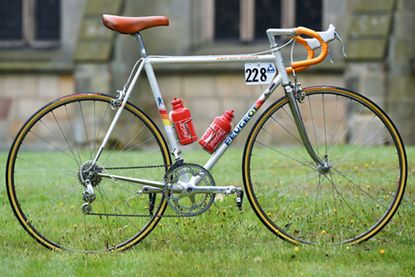
All photos: Andy Jones
Having sold the Peugeot upon which he rode the 1987 Tour de France , Adrian Timmis could only assume it had gone the same way as most other old team bikes do: cascading through the second-hand market and eventually left rusting, wheel-less, outside a student union somewhere.
That was until someone got in touch with him in 2011 on Facebook to say they had it.
“The guy had raced on it as a junior and then it had just been stuck in his shed,” Timmis recalls. “I couldn’t believe it when I started reading the message. We weren’t even friends on Facebook. I thought it was long gone.”
That’s my bike
The former ANC rider had always regretted selling the machine through Swinnerton Cycles in 1988. So after seeing some photos from his Facebook correspondent, Timmis offered to buy it.
“It had Brian Rourke transfers on it, but I could tell it was mine. I recognised the handlebar set-up and everything,” he says.
Good as new
With the bike back in his hands, Timmis set about returning it to its original state — getting
it resprayed and replacing finishing touches.
Get The Leadout Newsletter
The latest race content, interviews, features, reviews and expert buying guides, direct to your inbox!
Last summer he rode the machine up Alpe d’Huez in full replica regalia to relive the day exactly 28 years earlier where he’d raced on the climb as a member of the Tour’s peloton.
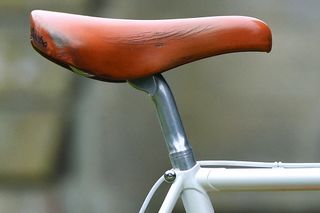
Timmis rode Turbo saddles for a number of years and maintains that this one is still comfy today. “It looks clunky but the profile is no different from modern saddles,” he says. “They’re just more cut-out.”
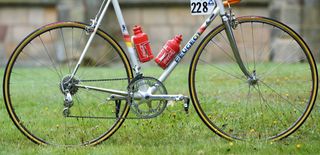
These were a pair of spare wheels in the 1987 season equipped with Record hubs on Campagnolo Pavé rims. Timmis’s race wheels had C-Record hubs.
ANC shod their wheels with Wolber tubs in 1987, but with the French company now defunct, Timmis has gone for a pair of Vittoria Corsa Evo SCs.
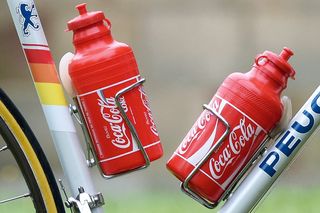
Coca-cola bottles were something of an icon on the Tour de France. Between 1985 and 2003, a sponsorship agreement between the drinks company and the race stipulated that they were the only bidons riders could use. Timmis kept a couple from 1987 along with his race number.
Handlebar tape
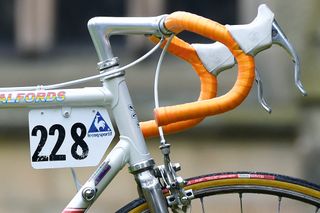
Benotto tape would be found on many bikes of the time, providing handlebars with a neat, shiny, wipe-clean but not very absorbent finish.
>>> The best handlebar tape, and how to wrap it (video)
“You had to wear track mitts,” says Timmis. He found this tape on eBay, its colour actually advertised as ‘ANC orange’.
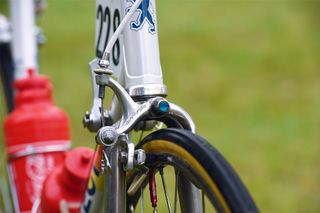
The alternative to Campag’s centre-pull Deltas, the C-Record Cobalto calipers had a distinctive single cobalt blue pivot.
>>> Icons of cycling: Mafac Racer brakes
“These are brilliant,” says Timmis. “When I came down Alpe d’Huez last year, they were awesome.”
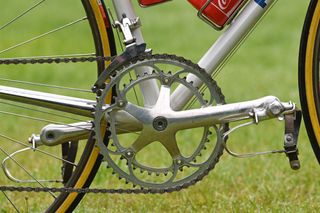
There’s no mistaking the beautiful, smooth lines and polished finish of Campagnolo C-Record.
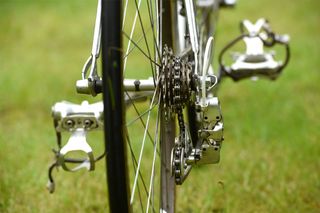
The shifting predates indexing and the chainrings are 52/40 paired with a seven-speed 13-24t block of sprockets at the back. A 25 or 26t sprocket would have been employed in the mountains.

Made from Reynolds 753 tubing with chromed 531 forks and stays, Timmis had the frame repainted by a local car sprayer and custom decals made by a specialist.
>>> Icons of cycling: Reynolds 531 tubing
“Folklore had it we were riding custom-built Cougars,” says Timmis. “Some of the others on the team were, but this really was an off-the-peg Peugeot from France with Simplex dropouts.”
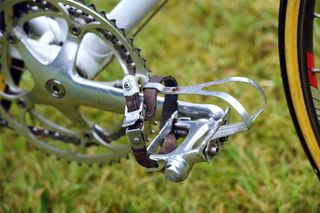
Clipless pedals were still emerging in 1987 and, like the majority of the Tour field, Timmis was still on clips and straps — C-Record ones.
>>> Icons of cycling: Look’s revolutionary clipless pedals
It wasn’t until 1990, after trying out “some daft Adidas ones where you had to press a button to clip in” and a similarly unsatisfactory pair from Campag, that Timmis fully committed to clipless with a pair of Look pedals.
Pride of place
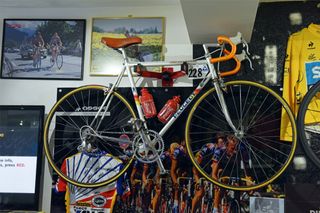
The Peugeot is now hanging in Cadence Sport along with other cycling memorabilia that Timmis has collected over the years. Note the CW poster top left!
Conquer any climb
The class of 1987
On July 1, 1987, Adrian Timmis was one of four British ANC-Halfords riders lined up at the start of the Tour de France in West Berlin. Under-prepared and under-funded, the team was out of its depth, but Timmis, along with three team-mates, made it to Paris.
Without a proper build-up to his first Grand Tour, the fact that a 23-year-old Timmis made it to Paris at the end of one of the fastest, hottest ever Tours, was nothing short of a miracle.
Team boss Tony Capper disappeared during the final week, leaving Phil Griffiths to take up the reins. The team’s story became a small piece of British cycling folklore, and was documented in the book Wide Eyed and Legless by Jeff Connor.
Thank you for reading 20 articles this month* Join now for unlimited access
Enjoy your first month for just £1 / $1 / €1
*Read 5 free articles per month without a subscription
Join now for unlimited access
Try first month for just £1 / $1 / €1
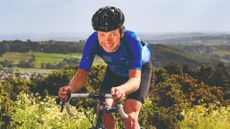
A great ride can quickly turn from cherished memory to nagging reminder of your subsequent inadequacy, bemoans Dr Hutch
By Michael Hutchinson Published 23 June 24

Keeping your electric bike clean shouldn’t be any more difficult than a standard bike, just be gentle with it
By Paul Norman Published 22 June 24
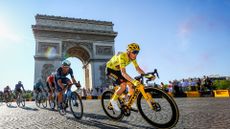
Nine of the ten bikes came from Italian manufacturers
By Michelle Arthurs-Brennan Last updated 29 June 23
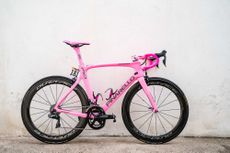
A closer look at the custom-pink Pinarello on which Froome entered Rome on May 27
By Paul Knott Published 23 December 18
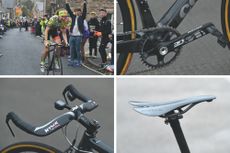
New hill-climb champion Lou Bates won on a bike made up of parts from the auction site eBay
By Jack Elton-Walters Published 17 November 16
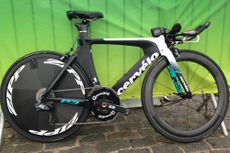
Emma Pooley was riding a specially made Cervelo P3 at the Olympic women's time trial, with 650c Zipp wheels and custom made USE handlebars and stem.
By Henry Robertshaw Published 10 August 16
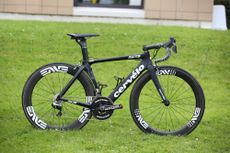
Here's a look at the Cervélo S5 that Team Dimension Data sprinter Mark Cavendish will be looking to ride to stage victories at the Tour de France
By Nick Busca Published 1 July 16

What do you talk about when you're waiting at the verge of the pave for the Tour de France to arrive? The weather and your nation's sporting misfortunes.
By Cycling Weekly Published 10 July 14
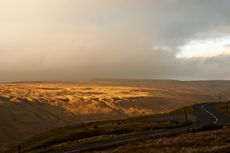
Stage one: Full route details
By Nigel Wynn Published 1 February 14
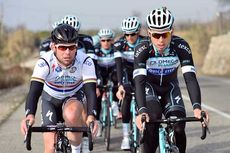
Mark Cavendish aiming to claim the yellow jersey when the Tour de France starts in Yorkshire this July
By Gregor Brown Published 31 January 14
Useful links
- Tour de France
- Giro d'Italia
- Vuelta a España
Buyer's Guides
- Best road bikes
- Best gravel bikes
- Best smart turbo trainers
- Best cycling computers
- Editor's Choice
- Bike Reviews
- Component Reviews
- Clothing Reviews
- Contact Future's experts
- Terms and conditions
- Privacy policy
- Cookies policy
- Advertise with us
Cycling Weekly is part of Future plc, an international media group and leading digital publisher. Visit our corporate site . © Future Publishing Limited Quay House, The Ambury, Bath BA1 1UA. All rights reserved. England and Wales company registration number 2008885.
1987 Tour de France (Q478420)

Identifiers
Wikipedia (23 entries).
- arwiki سباق طواف فرنسا 1987
- astwiki Tour de Francia 1987
- brwiki Tro Bro-C'hall war varc'h-houarn 1987
- cawiki Tour de França de 1987
- dawiki Tour de France 1987
- dewiki Tour de France 1987
- enwiki 1987 Tour de France
- eswiki Tour de Francia 1987
- euwiki 1987ko Frantziako Tourra
- fiwiki Ranskan ympäriajo 1987
- frwiki Tour de France 1987
- fywiki Omgong fan Frankryk 1987
- huwiki 1987-es Tour de France
- itwiki Tour de France 1987
- jawiki ツール・ド・フランス1987
- lvwiki 1987. gada Tour de France
- nlwiki Ronde van Frankrijk 1987
- nowiki Tour de France 1987
- plwiki Tour de France 1987
- ptwiki Tour de France de 1987
- slwiki Dirka po Franciji 1987
- svwiki Tour de France 1987
- trwiki 1987 Fransa Bisiklet Turu
Wikibooks (0 entries)
Wikinews (0 entries), wikiquote (0 entries), wikisource (0 entries), wikiversity (0 entries), wikivoyage (0 entries), wiktionary (0 entries), multilingual sites (0 entries).
Navigation menu
Category : Tour de France 1987
Subcategories.
This category has only the following subcategory.
- Tour de France maps 1987 (2 F)
- 1987 sports events in France
- 1987 in cycling (sport)
- Tour de France by year
- Uses of Wikidata Infobox
Navigation menu
Tour de France 2024 – Comprehensive team-by-team guide
A full rundown of all the teams, their leaders and the riders to watch at this year's race

Alpecin-Deceuninck
Arkéa-b&b hotels, astana qazaqstan, bahrain victorious, decathlon ag2r la mondiale, dsm-firmenich postnl, ef education-easypost, groupama-fdj, ineos grenadiers, intermarché-wanty, israel-premier tech, jayco-alula, lotto-dstny, red bull-bora-hansgrohe, soudal-quickstep, totalenergies, uae team emirates, uno-x mobility, visma-lease a bike.
As the 2024 Tour de France rolls out from Florence, Italy on June 29, there will be 176 riders competing across 22 teams – some with a target on overall victory, others looking for stage wins and more still pleased with any opportunity that comes along their way to gather publicity on the biggest cycling stage in the world.
All 18 WorldTour teams, plus the two best-ranked ProTeams – Israel-Premier Tech and Lotto-Dstny – got their automatic invitations to race while organisers ASO handed out wild card entries to Uno-X Mobility and TotalEnergies.
Crashes, form and Olympic goals have shaped the selections and ambitions for the teams but regardless all will be fighting to make an impression as the 21 days of racing over 3497.3km from Tuscany to Nice in the south of France unfolds.
Cyclingnews has pored through every squad, assessing their leaders, objectives and chances of success to bring you this comprehensive team-by-team guide.
- Team leader: Jasper Philipsen
- Objective: Stage wins, points classification
- Rider to watch: Mathieu van der Poel

In the bunch sprints of the Grand Tours of recent years, one team has stood out above the rest as masters of the lead-out train: Alpecin-Deceuninck .
They were a prominent presence throughout the bunch finishes at the recent Giro d’Italia, but Kaden Groves wasn’t able to ride them to victory. However, at the Tour de France, the team will have Jasper Philipsen , the quickest sprinter in the peloton.
Philipsen was one of the stars of last year’s Tour, storming to four stage wins (as many as any sprinter has managed at a single Tour since the 2011 edition), as well as riding consistently enough to claim the green jersey. He didn't slow down this spring, either, with victories at Milan-San Remo and the Classic Brugge-De Panne, as well as a second place at Paris-Roubaix, among his very impressive results.
Not only is Philipsen the quickest sprinter in the race, but he’ll also have the quickest lead-out man riding for him in Mathieu van der Poel . The pair work brilliantly together, as seen not just at last year’s Tour sprints, but also during the spring, when Van der Poel helped Philipsen to triumph at Milan-San Remo, and vice versa at Paris-Roubaix.
Van der Poel will also go hunting for stage wins on appropriate stages, most likely on days with punchy parcours too hard for sprinters but not hard enough for climbers. For a man so untouchable in the Classics, it’s perhaps surprising that he only has one stage win to his name from three Tour appearances, but he has often ridden here with a future goal in mind, as will be the case this year as he builds towards the Olympics.
- Team leader: Arnaud Démare
- Objective: Stage wins
- Rider to watch: Kévin Vauquelin
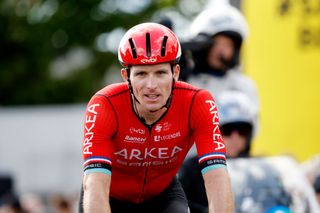
With Warren Barguil having followed Nairo Quintana out the door, Arkéa-B&B Hotels are going in a fresh direction for the 2024 Tour with sprinter Arnaud Démare as their new talisman.
Having grown increasingly frustrated with the lack of opportunities provided him by his former Groupama-FDJ team, who selected him for only one Tour de France start in the last five years, Démare has moved to a team where he won’t just be picked but will command unified support behind him.
It’s hoped that as a winner of two Tour stages in the past, Démare can deliver the team their long-awaited first-ever following ten winless Tours, but does the Frenchman have the shape to do so? He hasn’t made the top ten of any race for almost four months, and recently fractured a finger at the 4 Jours de Dunkerque, plunging his Tour preparations into doubt.
It could therefore be up to others in the line-up to deliver, from which Kévin Vauquelin has shown particular potential. The 23-year-old has done everything this year, from making the top 10 at both Itzulia Basque Country and Tirreno-Adriatico, finishing second on the Mur de Huy at La Flèche Wallonne and winning a time trial at Etoile de Bessèges. He could be a contender for a variety of different stages though specialises in climbing hills and mountains.
- Team leader: Mark Cavendish
- Rider to watch: Alexey Lutsenko
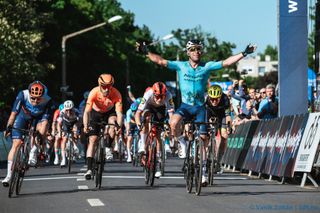
At last, it's nearly time for the race that Astana Qazaqstan 's whole season has been building up towards.
Since signing Mark Cavendish in January 2023, they've made it their foremost mission to deliver the Manxman to the elusive win number 35, move clear of Eddy Merckx, and thereby become the outright record holder for most stage wins at the Tour de France.
It had initially been intended as a one-year plan, but after the heartbreak of last year’s race, where Cavendish crashed out at the end of the first week , he and the team have decided to have one last shot at history this July.
Unlike last year, when he went into the Tour off the back of a final-day victory in Rome at the Giro d’Italia, Cavendish has shown only sporadic signs of form this season, confined to smaller races. He won a stage during his first race of the season at the Tour of Colombia in February but had to wait another three months for a first victory on European roads at the Tour of Hongrie. His recent participation at the Tour de Suisse was mainly to sharpen his climbing form ahead of the Tour de France.
The Astana team is set to be built entirely around him. Veteran lead-out master Michael Mørkøv was signed exclusively to deliver him in the sprints, while Cees Bol and Davide Ballerini will sacrifice their own sprinting ambitions to form part of his lead-out train.
One rider who might be granted some freedom to ride for himself is Alexey Lutsenko . He showed great form by winning Il Giro d’Abruzzo before abandoning the Giro d’Italia and finishing seventh and eighth on GC in 2021 and 2022, respectively. He has two Tour de France GC top 10s, as well as a stage win in 2020, on his palmarès, so another top showing isn't out of the question.
- Team leaders: Pello Bilbao
- Objective: GC, stage wins
- Riders to watch: Santiago Buitrago, Matej Mohorič
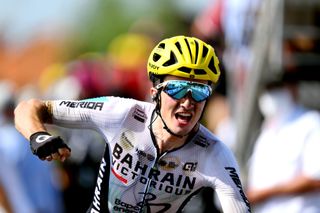
What Bahrain Victorious lacks in a single stand-out GC contender, they make up for in strength in depth. Following Antonio Tiberi’s fifth place at the Giro d’Italia, they’re hoping to extend their run of top-six finishes on GC to a fifth consecutive Grand Tour and have several riders potentially capable of doing so.
Their best candidate is Pello Bilbao , based on his performance at the Tour last year and in stage races so far in 2024. He was sixth place last year and has been building nicely towards that level again this year with sixth-place finishes at Volta a la Comunitat Valenciana and Itzulia Basque Country, plus third at the UAE Tour in between. He was also second overall at the Tour of Slovenia, and while the field was not the same level as what he will face at the Tour de France, the results undoubtedly helped to build confidence.
Santiago Buitrago is poised to make his Tour debut. He brings with him considerable expectations off the back of his stage wins and top-ten finish at the Giro d’Italia and Vuelta a España, respectively, as well as his impressive showing at Paris-Nice earlier this year.
It’s also hoped that Jack Haig can rediscover some form ahead of the race, while even veteran Wout Poels could post a high GC finish based on his recent third and sixth-place finishes at the Tour de Hongrie and Tour of the Alps, respectively.
Poels and Bilbao were two of the three different riders to win a stage at last year’s Tour, along with Matej Mohorič, who will again be using his nous and engine to target breakaways. The Slovenian has three Tour stage wins on his career palmarès, and it wouldn't be a surprise to see him add another win here.
With Phil Bauhaus , a debutant last summer, also posing a threat in the bunch sprints, Bahrain Victorious has the resources to target a win on almost every stage.
- Team leaders: Guillaume Martin
- Riders to watch: Bryan Coquard, Ion Izagirre.
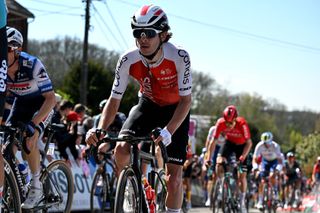
For the first time in many years, Cofidis can go into a Tour de France without being badgered about questions of whether this will be the year they at last manage to claim a stage win.
By triumphing on stage 2 of last year’s edition, Victor Lafay ended the team’s 15-year drought, and then Ion Izagirre added another stage a week later.
Lafay has since left for Decathlon AG2R La Mondiale, but Izagirre remains and is set to ride, with stage wins on hilly and mountainous days again likely to be the target.
Guillaume Martin will ride his eighth consecutive Tour de France and will be the team’s leading GC hope. He’s placed eighth, 10th, 11th and 12th in past appearances but has never won a stage, so he may prioritise trying to take one from a breakaway. He recently finished 19th overall at the Critérium du Dauphiné with a top 10 in a stage, but will be aiming to improve on that at the Tour.
Bryan Coquard is another rider without a Tour stage win to his name despite many near misses, including a couple of fourth-place finishes last year. He’ll be the team’s man for the bunch sprints, especially on hillier days that weaken the specialists.
While these riders bring experience, 25-year-old Axel Zingle has form and potential. He’s been consistently in contention for multiple semi-Classics over the last few months and could win from a breakaway if he picks the right move.
- Team leader: Felix Gall
- Rider to watch: Sam Bennett, Benoît Cosnefroy

In the middle of an exceptional season, in which they have already racked up more victories than they managed in the last two seasons combined, expectations are high for Decathlon AG2R La Mondiale as they head into the biggest race of the year.
Although the men who delivered stage wins (Valentin Paret-Peintre and Andrea Vendrame) and fourth overall (Ben O’Connor) at the Giro d’Italia will sit this one out as they rest and recover, the core of the other names who have made 2024 such a success are set to be present.
Benoît Cosnefroy has been the team’s biggest contributor with seven of their 23 wins (as of the end of May) and will target the hilly stages, while Dorion Godon will be a candidate in reduced bunch sprints, having won two sprint finishes at the Tour de Romandie in late April.
In the pure flat finishes, Sam Bennett will still be their main candidate, having recently shown signs of returning to form with a haul of wins and GC at the 4 Jours de Dunkerque.
Felix Gall might have had a quieter season to date, but he'll still be the team’s main man for the mountains and their GC candidate, and is looking to be on target with a 10th overall at the Tour de Suisse. He finished eighth overall last year after breaking through with a series of good performances in the spring, while he'll also be hoping to replicate his breakaway stage win at Courchevel.
- Team leader: Fabio Jakobsen, Romain Bardet
- Rider to watch: Warren Barguil

For the Tour de France, DSM-Firmenich PostNL are making the unusual move of deploying the same two leaders as they did at the Giro d’Italia.
In the bunch sprints, Fabio Jakobsen will again line up as he continues to rediscover his mojo. The Dutchman still only has one win to his name (at the Tour of Turkey) since signing for the team this year, and he failed to get involved in the Giro bunch sprints before abandoning during the second week. However, the team still retains faith that he can reach the level that saw him win a stage on his Tour debut two years ago.
Romain Bardet fared better at the Giro than Jakobsen, finishing ninth overall while coming close to a stage win on Bocca della Selva. Though he has made the top 10 in all but two of the eight Tours he has finished throughout his career, his excursions in Italy may mean he targets stage wins this time instead.
With 11 wins to their name – including just one WorldTour race and only three outside the Tour of Turkey – DSM need some big results. That means that another French climber, Warren Barguil , will likely be given the freedom to attack and get into breakaways.
- Team leader: Richard Carapaz
- Rider to watch: Neilson Powless, Ben Healy
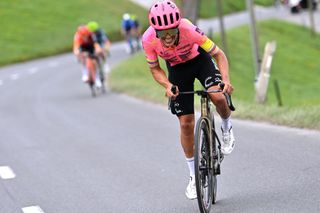
Last season was the first in EF Education-Easy Post ’s 16-year history that they did not place a rider in the top 10 of any of the Grand Tours. That run continued at the Giro d’Italia last month, where they aggressively targeted stage wins rather than GC via constant attacks, and were eventually rewarded in the final week with success from Georg Steinhauser in the Dolomites.
Nevertheless, they intend to strive to finish as high as possible at the Tour with Richard Carapaz as their leader. The 2021 podium finisher and 2019 Giro champion was signed in 2023 to do precisely that but he endured an under-par season last year and is only just showing signs of some form recently, with a stage win and seventh overall at the Tour de Romandie.
However, Carapaz and Alberto Bettiol were forced to abandon the recent Tour de Suisse after crashing on stage 4, but expressed that their 'goal remains the Tour de France'.
With Carapaz’s form still uncertain, there ought to be plenty of scope for the rest of the line-up to chase their own personal ambitions. Neilson Powless , for instance, could either chase GC as he did in 2023 (when he finished 12th), or stage wins and the polka-dot jersey as he did last year.
Irish puncheur Ben Healy is set to make his Tour debut, and if his Giro debut from last year and performances in the Classics are anything to go by, we can expect him to attack at every opportunity.
Alberto Bettiol ’s form during the spring suggests he could add a Tour stage win to the one he managed at the 2021 Giro, while Marijn van den Berg has also earned a spot on the team thanks to his impressive early season performances.
- Team leader: David Gaudu
- Rider to watch: Stefan Küng

A new dawn awaits Groupama-FDJ as they embark upon the first Tour de France of the post-Thibaut Pinot era. Before retiring at the end of last year, Pinot had been the fulcrum of the team, appearing for them in all but two of the last 12 editions — sometimes with great success, other times with great heartbreak.
David Gaudu will seek to fill the void left by Pinot, as he has for several years now. Fourth overall in 2022 remains his highest finish at any Grand Tour, and though a repeat of that looks ambitious given his stuttering form this year, he’s still dreaming of a podium finish.
If Gaudu doesn’t have the legs to mount a serious GC challenge, targeting stage wins may be the team’s optimum approach, and they have plenty of riders capable of delivering on that front.
Rising star Lenny Martinez misses the race in favour of the Vuelta a España, but 21-year-old Romain Grégoire is set to make his Tour debut on the back of some very impressive results this year, including a stage win at Itzulia Basque Country
Valentin Madouas has become a recognisable face from recent Tours without quite winning a stage, though he certainly has the talent to do so. Stefan Küng , newly crowned Swiss champion in the time trial, will, as ever, be a candidate for both the time trials as well as select breakaways.
- Team leaders: Carlos Rodríguez, Egan Bernal
- Objective: GC
- Rider to watch: Tom Pidcock, Geraint Thomas

Last year was only the second time in the last decade that Ineos Grenadiers failed to put a rider on the GC podium at the Tour de France. Even since their run of yellow jersey-winning Tours came to an end in 2020, up until then they had still managed to crack the podium through Richard Carapaz (in 2021) and Geraint Thomas (in 2022), but last year their highest finisher, Carlos Rodríguez , finished further down in fifth place.
Still, that result means Rodríguez is one of the more obvious choices to lead the team’s 2024 GC bid, and the 23-year-old has bolstered his status with overall victory at the Tour de Romandie, second place behind Juan Ayuso at Itzulia Basque Country and fourth overall at the Critérium du Dauphiné.
Also in the squad are other, more wildcard options for GC. Geraint Thomas would usually be a dependable candidate, but it’s unclear how fresh he will be, having dug deep to seal third place at the Giro d’Italia .
Egan Bernal and Tom Pidcock showed Tour de France leadership form at Tour de Suisse , finishing fourth and sixth place, respectively.
Pidcock has stated that he intends to concentrate on the GC rather than stage wins, despite failing to make the top ten last year and remained in Switzerland for additional training before heading to the Grand Depart.
And Bernal, the 2019 champion, has for the first time since his horror crash two and a half years ago shown form approaching his best, with third overall at Volta a Catalunya, top tens at Paris-Nice and the Tour de Romandie, and fourth at the Tour de Suisse but it remains to be seen if he can manage a sustained GC bid over three weeks.
Michał Kwiatkowski and Laurens De Plus will be on hand to help the aforementioned trio achieve their GC goals, even if the Belgian could harbour ambitions of his own after racing to an unexpected and impressive fifth overall at the Critérium du Dauphiné.
- Team leader: Biniam Girmay, Louis Meintjes
- Rider to watch: Georg Zimmermann

Biniam Girmay returns to the Tour de France hoping for a positive turn in fortunes. So far, his season has been blighted by interruptions, with promising form in the early spring classics halted by a crash at Dwars door Vlaanderen and another crash spelling the end of his Giro d’Italia one day after finishing third in Fossano.
He’s since returned to winning ways with victory at the Circuit Franco-Belge , and looks on course to arrive at the Tour in form. As Intermarché-Wanty ’s star, the onus is on the Eritrean to make an impact and he has the chance to make history as the first-ever Black African to win a stage of the Tour de France. His consistency and versatility also make him a candidate for the green jersey.
Like Girmay, who failed to show his best self at last year’s Tour, Louis Meintjes will be hoping to return to the form that saw him finish seventh overall in 2022 rather than crash out last year.
Meintjes will be the team’s GC leader, but the rest of the line-up will have the freedom to get into break and chase stage wins, much as Georg Zimmermann (who was second on stage 10) did last year. Rouleurs like Laurenz Rex and Hugo Page might fancy their chances of winning a stage this way, too.
- Team leader: Stephen Williams, Derek Gee
- Rider to watch: Pascal Ackermann

Israel-Premier Tech 's high ambitions from 2021, when they gambled on signing Chris Froome in the hope that he could recover from his horror crash two years earlier and revive his Tour-winning form of old, have since been significantly tempered.
Now no longer a WorldTour team, they've instead depended upon a wildcard to earn entry into the Tour de France, and their hopes are limited to chasing stage wins rather than mixing it up in the battle for the yellow jersey.
Froome was fighting for selection and eager to avoid a repeat of last year when he was left out of the Tour line-up, but he will once again not start the Tour de France with Israel-Premier Tech .
The team has put their support behind Stephen Williams and Derek Gee with the aim of winning stages at this year's event.
Williams is enjoying a terrific season, having won both La Flèche Wallonne and the Tour Down Under, and recently finished second in a stage at the Tour de Suisse. He'll, therefore, be a top contender for stage wins in the hilly terrain.
Gee, who last year burst onto the scene with a series of breakaway second places at the Giro d'Italia, makes his Tour debut in the form of his life after scoring a stage win and third overall at the Critérium du Dauphné .
The team should have a presence in the sprints, where Tour debutant Pascal Ackermann aims to add to his Giro d’Italia and Vuelta a España stage wins and complete the Grand Tour clean sweep. The rest of the line-up will be made up of stage hunters such as Dylan Teuns (who won here in both 2019 and 2021).
- Team leader: Simon Yates, Dylan Groenewegen
- Riders to watch: Michael Matthews
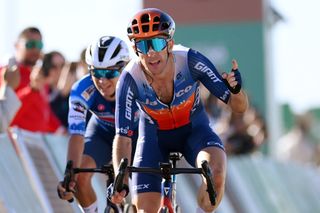
For a second successive season, Jayco-AlUla leader Simon Yates has foregone his usual Giro d’Italia participation in order to concentrate more committedly on the Tour de France.
Last year, this approach turned out to be a success, as he came to the Tour with some of the best legs of his career, eventually finishing fourth overall, and only missing out on a podium finish by 87 seconds to his brother Adam. His build-up to this year’s Tour isn’t so encouraging, however, having not shown much form since winning the AlUla Tour in the winter.
However, he will lead the general classification charge with key support rider Chris Harper alongside, as he hopes to, this year, break Visma-Lease a Bike and UAE Team Emirates' stranglehold on the podium.
Jayco-AlUla aren’t putting all their eggs in the single basket of Yates’ GC bid. Dylan Groenewegen , who recently won a stage at the Tour of Slovenia, will be led out in the sprints by the likes of Luka Mezgec to see if he can add to his five Tour career stage wins, having come close last year with a second and third-place finish at Moulins and Paris, respectively.
On days too hilly for Groenewegen, Michael Matthews , recently second in a stage at the Tour de Suisse, will step up and may also try to get into some breakaways as he did to win a stage in 2022. He looked in fantastic form this spring, placing second at Milan-San Remo and, before being relegated for deviating from his line, third at the Tour of Flanders.
- Team leader: Mads Pedersen
- Objective: stage wins
- Rider to watch: Giulio Ciccone

As a team boasting a diverse range of talent, Lidl-Trek could feasibly compete for all a couple of major jerseys.
For the yellow jersey, they had high hopes for Tao Geoghegan Hart , but COVID-19 and a fractured rib due to a crash at the Dauphiné prevented him from toeing the start line . He’s only done the Tour de France once in his career and was eager to target GC here while still in his prime years.
Mads Pedersen finished a distant second to Jasper Philipsen in the points classification last year, though he did score his second stage win in as many years. He's shown the kind of excellent form throughout this year to suggest he could bridge that gap, as well as add to his stage win tally. His victory in the opening stage at the Dauphine suggests that he is in great form heading into this Tour.
As for the king of the mountains, Giulio Ciccone won that classification last year and will now be present to potentially defend that title after saddle sore surgery forced him to skip the Giro d’Italia. Unfortunately, he was also unwell due to the flu following the Dauphiné, and so his form is uncertain.
Lidl-Trek might even have had a prime candidate for the white jersey if Matias Skjelmose had opted to ride, but he plans to skip the Tour and save himself for a Vuelta a España overall bid instead.
- Team leader : Arnaud De Lie
- Rider to watch: Maxim Van Gils
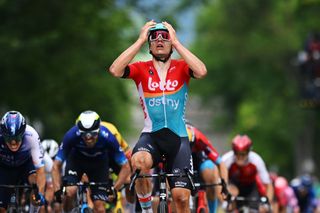
Compared to other teams, Lotto-Dstny have a laser-focussed approach when it comes to the Tour de France. Not only will it be their first Grand Tour of the season, having opted out of the Giro d’Italia, but they have also narrow down their ambitions to focus exclusively on stage wins, having not placed a rider in the top 10 for 14 years.
They haven’t had success on these terms recently, though, with no stage win to their name since Caleb Ewan’s victories in the sprints during the 2020 edition. The Australian has led the team for the past five Tours, bringing much success initially with multiple stage wins in 2019 and 2020, but nothing in the three editions since then.
He’s now left the team for Jayco-AlUla, and taking his place as Lotto’s leader will be Arnaud De Lie . Much is hoped from the 22-year-old debutant based on his rapid rise over the past two years, and he'll be especially threatening on hillier days where the pure sprinters will struggle.
However, the Tour will be a big step up from the level of competition he’s used to, and he’s only recently r eturned to form after suffering from Lyme disease during the spring. A recent podium finish in a stage at the Tour de Suisse suggests that he is taking a step forward ahead of the Tour.
De Lie might be the most hyped name, but another young Belgian, Maxim Van Gils , has been the team’s best performer so far this season. He finished second on the stage to Grand Colombier last year and has since established himself as one of the very best puncheurs in the world following podium finishes at Strade Bianche and La Flèche Wallonne, and a fourth place at Liège-Bastogne-Liège.
2023 super-combativity winner Victor Campanaerts is also set to ride again, though his season to date has been a quiet one.
- Team leader: Enric Mas
- Rider to watch: Rémi Cavagna

2024 has so far been another difficult season for Movistar , with Pelayo Sánchez’s stage victory at the Giro d’Italia their only win at WorldTour level all year.
That doesn’t bode well for their prospects at the Tour de France, where they have, in recent years, laboured to reach the levels of the past. They’ve now gone two successive Tours without placing a rider in the top 10, having done so in eight of the nine previous editions.
If any of their roster is to break that duck, it’ll be Enric Mas . The Spaniard has generally been one of the most dependable GC riders of his generation, making the top six in six of his last eight Grand Tour appearances.
However, he has been forced to abandon both of his last two Tours de France, with his participation last summer ending on the first day following a crash.
So far, Mas has enjoyed a solid season without causing too much of a stir, finishing fifth overall at Volta a Catalunya, sixth at the Tour de Romandie and seventh at the Tour de Suisse. Considering that he normally ups his game for the Grand Tours, that’s encouraging.
The team also have Alex Aranburu , who recently won a stage and finished third overall at the Baloise Belgium Tour. He could be marking stage wins and a support role.
New signing Rémi Cavagna is a dependable name in the time trials, breakaways and in helping team leaders on the flat, though the Frenchman hasn't scored a WorldTour win of his own since 2021. Returning star Nairo Quintana won't make the race, meanwhile, after breaking his hand in a crash at the Tour de Suisse.
- Team leaders: Primož Roglič
- Riders to watch: Jai Hindley, Aleksandr Vlasov

For the 2024 season, Red Bull-Bora-Hansgrohe signed Primož Roglič with the primary objective of winning the Tour de France.
The team might never before have made the podium at any previous edition in their 10-year history, but Roglič has the calibre to challenge for yellow, as well as the desire, having moved from Visma-Lease a Bike for that specific purpose.
The Slovenian has left it to the last minute to show the kind of form he'll need to challenge for the yellow jersey, with his Critérium du Dauphiné victory his best showing of 2024 so far. The week-long warm-up race marked his first race since the heavy crash suffered by him, Remco Evenepoel, and Jonas Vingegaard at Itzulia Basque Country.
His two stage wins at the late summit finishes at Le Collet d'Allevard and Samöens 1600 were his first since the opening day at Itzulia, though a shaky final stage showing – where he shed almost a minute to Matteo Jorgenson and only held onto yellow by eight seconds – could provoke some cause for concern.
Roglič’s presence means last year’s leader Jai Hindley — who enjoyed a day in the yellow jersey after winning stage five in Laruns before back pain contributed to a slip down to seventh on GC — will be demoted to the role of super-domestique.
While Hindley’s form has tailed away since his impressive third-place finish at Tirreno-Adriatico, Aleksandr Vlasov might believe he has the results to justify potential co-leadership status. With a second place at Tour de Romandie, sixth at Volta a Catalunya and fifth at Paris-Nice, he has been among the team's top performers this year. At the Dauphiné, he proved a reliable and strong deputy for Roglič.
Elsewhere, the rest of the team is geared exclusively towards targeting the yellow jersey, with Champs-Elysées-winning sprinter Jordi Meeus missing out on selection as the team looks to domestiques Danny van Poppel , Nico Denz , Marco Haller , Matteo Sobrero , and Bob Jungels .
- Team leader: Remco Evenepoel
- Rider to watch: Mikel Landa, Ilan Van Wilder

In a drastic change of approach, Soudal-QuickStep have abandoned their usual Tour de France strategy of targeting bunch sprints and stage wins, and instead are going all-in on Remco Evenepoel ’s push for GC.
This is set to be Evenepoel’s debut Tour, and it’s a hugely anticipated one, given the already enormous star profile he’s built for himself through many superb performances and major results, including two Liège–Bastogne–Liège victories, the world title in 2022, and the GC at the Vuelta a España that same year.
His build-up has been compromised after a crash and fractured collarbone at Itzulia Basque Country stalled the momentum that had already seen him win Volta ao Algarve and finish second at Paris-Nice, but the plan remains the same.
His first race back, the Critérium du Dauphiné, saw him score a dominant time trial win. However, he faded hard in the closing three mountain stages, losing 2:25 to Primož Roglič and finishing seventh overall in the GC. That will be a major cause for concern heading into July.
As part of the team building around Evenepoel, Mikel Landa has been signed up as a super-domestique. The Spaniard has performed this role in the past – at Sky to help Chris Froome win the 2017 Tour de France and at Movistar for Richard Carapaz’s 2019 Giro d’Italia triumph. Second at Volta a Catalunya and 10th at the Dauphiné suggests he has the legs to do something similar this year, too
Landa will be joined by Evenepoel’s familiar right-hand man, Ilan Van Wilder . The Belgian has ridden in support of Evenepoel many times, most notably during his triumphant Vuelta a España effort two years ago and should be in solid form, too, having placed fourth at the Tour de Romandie.
The team’s focus on GC means there will be no room for in-form sprinter Tim Merlier, despite his success at the Giro d’Italia, nor even home favourite Julian Alaphilippe, as the remaining spots instead go to domestiques including Yves Lampaert , Casper Pedersen , Louis Vervaeke and Gianni Moscon .
- Team leader: Mathieu Burgaudeau
- Rider to watch: Steff Cras

When TotalEnergies signed Peter Sagan for the 2022 season, they hoped the Slovakian would be the star name to make them protagonists at the Tour de France. His first edition for them was typically consistent, finishing in the top six of five different stages, but lacking the edge of his heyday; by the following year his powers had seriously waned, and he only made the top ten once.
Now that Sagan has retired, the team must embark on a new direction. They’ve struggled at the Tour in recent years and haven’t won a stage since Lilian Calmejane in 2017.
It will be hard for them to break that duck this year. Of the four non-WorldTour entries, they probably have the weakest roster, as reflected by the fact that they’d only won three races this season as of the beginning of June.
Consequently, their strategy will be to buy daily tickets in the lottery that is getting into the breakaway. Mathieu Burgaudeau is a particular specialist at this, having finished second and third on stages of last year’s race, and placed second in the King of the Mountains classification at this year’s Paris-Nice riding similarly aggressively.
The likes of Pierre Latour, Anthony Turgis, Geoffrey Soupe and Alexis Vuillermoz all provide experienced options for TotalEnergies to potentially select. And though the team don’t tend to target GC anymore, Stef Cras ’ 11th place finish at the Vuelta a España last year suggests he could become their first rider to crack the top ten since Pierre Rolland in 2015 — although his participation remains up in the air due to his involvement in the horror crash at Itzulia Basque Country.
- Team leaders: Tadej Pogačar
- Rider to watch: Adam Yates, Juan Ayuso
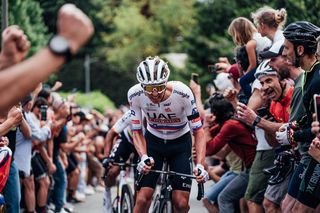
Phase one of UAE Team Emirates ’ great ambition to win the Giro/Tour double this year with Tadej Pogačar was a success, with the Slovenian waltzing to an enormous victory at the first Grand Tour . Now, it’s time for the hard part.
Pogačar won the Giro at a canter, almost 10 minutes clear of second place as he won a staggering six stages without ever appearing to have to stretch himself. But at the Tour, he’ll be up against a much stronger field of GC candidates, none of whom have the accumulated fatigue of having already completed a Grand Tour this season – even if Evenepoel, Roglič, and Vingegaard are all making comebacks from that brutal Itzulia crash.
UAE Team Emirates provided ample support to him at the Giro, with Rafał Majka and Vegard Stake Laengen impressing in particular, but the team is set to ring in the changes with an all-new line-up at the Tour.
On paper, it’s a much stronger group of riders, and the team have announced that recent winner of the Tour de Suisse Adam Yates , and runner-up João Almeida , along with Juan Ayuso will support Pogačar's bid for victory at the Tour de France .
In Yates, they have the man who finished third last summer, even if his form this year is in more doubt, having performed only in patches since winning the UAE Tour in February. Ayuso provides another potential GC option, making his Tour debut on the back of a podium finish at the Vuelta a España and overall victory at Itzulia Basque Country earlier this year.
More climbing firepower will come from Almeida, another rider who would slot in as a GC leader at most of the other teams in the peloton. Elsewhere, Pavel Sivakov and Marc Soler bolster the climbing line-up along with Tim Wellens and Nils Politt , the latter pairing set to feature in the engine room during flatter stages.
The team will be hoping Ayuso, Sivakov, Wellens, and Politt recover well from a mass spill at the Critérium du Dauphiné, with Ayuso forced out of the race with pain in both hips as a result.
- Team leader: Alexander Kristoff
- Riders to watch: Andreas Leknessund, Magnus Cort
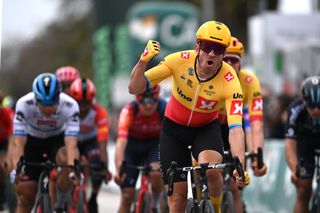
After making a successful Tour de France debut last year, Uno-X Mobility have been invited back by ASO as a wild card entry again.
Last year, they impressed by being active in the breakaways, with Tobias Halland Johannessen enjoying particular success with three top-six finishes. He’s set to return this year and on the back of some good form, too, having finished sixth at La Flèche Wallonne during the spring.
This time, they’ll have more strings to their bow. In new signing Andreas Leknessund , they have a rider capable of challenging for GC, even if he hasn’t yet shown the form this season that saw him finish eighth overall at the Giro d’Italia last year. And Magnus Cort brings considerable experience as a two-time former stage winner at the Tour, and will be dangerous from an intermediate stage break or reduced bunch sprint.
They will also again have Alexander Kristoff for the bunch sprints, who, though poised to turn 37 during the Tour, has been winning regularly this past month or so and could have it in him to add to his four career Tour stage wins.
But they are also sure to be one of the main presences in the breakaways, with Jonas Abrahamsen posing a particular threat, having recently won the Brussels Cycling Classic that way.
- Team leader: Jonas Vingegaard
- Rider to watch: Sepp Kuss, Wout van Aert
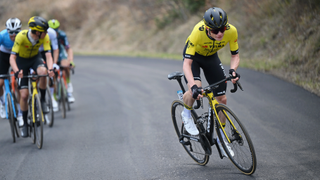
The final decision arrived just one week before the start of the Tour de France: Jonas Vingegaard and Wout van Aert were confirmed in Visma-Lease a Bike’s Tour de France line-up, ending weeks of speculation about their fitness and ambitions for the biggest race of the 2024 season.
But as the Tour approaches, however, Visma-Lease a Bike are still cautious on the fitness of Vingegaard. The defending champion’s participation was plunged into doubt when he crashed out of Itzulia Basque Country in April and hasn’t raced since. He has recently returned to training at high altitude, though his exact racing level won't become apparent before the Tour.
Given the severity of that fall, the fact he will return in time for the Tour de France feels miraculous, but doing so with the form to win the yellow jersey again will be an even bigger ask.
Prior to that crash, Vingegaard had started the season in intimidatingly good form, triumphing at both Tirreno-Adriatico and O Gran Camiño while claiming five stage wins in total, and would surely be the overwhelming favourite for yellow were it not for his fitness and form doubts.
The team has stated that Vingegaard has recovered enough from the crash to achieve a good result, while the Dane himself has said, “The last few months have not always been easy, but I thank my family and Team Visma-Lease a Bike for their unwavering support. We have worked together to get to this moment, and of course, I am very excited to see where I stand. I feel good and very motivated."
The team will also field Sepp Kuss , who could potentially fill a GC role. The peerless climbing super-domestique proved himself as a Grand Tour GC rider by winning the Vuelta a España last year, though he hasn’t shown anything like that form so far this year. On top of that, he abandoned the Critérium du Dauphiné before the final day of racing as he wasn't feeling 100% .
Like Vingegaard, Van Aert, too, was a doubt as he tried to recover in time from the injuries that ruled him out of both the Giro d’Italia and the major spring Classics, though he has returned to racing at the Tour of Norway.
Van Aert has won nine stages at the Tour de France and won the green points jersey in 2022. He was keen to return to the Tour after missing the Giro. He has stated that his main goal is to "ride a top classification with Jonas."
Also on the team will be Tiesj Benoot , Jan Tratnik, Christophe Laporte and Wilco Kelderman . Matteo Jorgenson will make for a very useful addition to the line-up, bringing a diverse range of talents that has this year seen him win Paris-Nice and Dwars door Vlaanderen and score a surprising second overall at the Dauphiné.

Thank you for reading 5 articles in the past 30 days*
Join now for unlimited access
Enjoy your first month for just £1 / $1 / €1
*Read any 5 articles for free in each 30-day period, this automatically resets
After your trial you will be billed £4.99 $7.99 €5.99 per month, cancel anytime. Or sign up for one year for just £49 $79 €59
Try your first month for just £1 / $1 / €1
Stephen Puddicombe is a freelance writer based in Bristol. He has written for Cyclingnews since 2020, and has covered cycling professionally as a freelancer since 2013, writing for outlets such as Rouleur , Cycling Weekly and Cycle Sport , among other publications. He is the author of The World of the Tour de France, published by Sona Books. Outside of cycling he is a passionate cinephile, and a long-suffering Spurs fan.
- Kirsten Frattini Deputy Editor
A score to settle – New team, same ambition for Primož Roglič at Tour de France
Tour de France bikes 2024: The ultimate equipment guide
Lotte Kopecky takes crushing road race victory at Belgian Championships
Most Popular

2024 Tour de France begins June 29 and includes historic firsts. Everything to know
The Paris Olympics and Paralympics will not be the only prestigious international sporting event held in France this summer.
The Tour de France, the preeminent event on the men’s cycling calendar, will return for its 111th edition from June 29 to July 21. During the three-week ride, 176 cyclists, representing 22 teams of eight, will complete 21 stages across hilly, flat and mountainous terrain. The course includes a grueling 52,230 meters (over 170,000 feet) of elevation gain and is 3,492 kilometers (2,170 miles) long. The taxing schedule includes only two rest days.
This year’s race will start in Florence, Italy, and conclude at the Promenade des Anglais in Nice, France. It will be the first time the finish line is not in or near Paris because the city will be hosting the Olympic and Paralympic Games. And the first time since 1975 the race will not finish on the Champs-Élysées.
The final stage will also break from tradition as it will be one of two time trial stages, which means the leader could be determined in the final leg. The last time the Tour de France ended with a time trial was in 1989.
In addition to Italy and France, the route passes through San Marino and Monaco. The route is famous for its picturesque scenery, from quaint rural villages to the towering Alps.
Each stage is timed, and the rider with the lowest cumulative time across all stages wins the acclaimed maillot jaune, or yellow jersey, to signify the general classification winner. Denmark’s Jonas Vingegaard, 27, hopes to seek a coveted three-peat but is still working his way back from a serious crash that hospitalized him for 12 days in April. If he does race, he will face fierce competition from a talented field that includes 2020 and 2021 winner Tadej Pogača of Slovenia.
Separate awards are also given to the best sprinter, climber and young cyclist.
Sepp Kuss, who finished as the top American in 12th place at last year’s Tour de France, is also set to return. Like last year, he will race on the same team as Vingegaard.
How to watch the 2024 Tour de France live
All stages of the Tour de France, as well as pre- and post-race coverage, will be available to stream live on Peacock. USA Network will also stream some of the stages.
NBC will simultaneously broadcast select stages of the event.
Stage 1 will begin June 29 at 6 a.m. ET. The rest of the stages typically start between 5 a.m. and 8 a.m. ET.
Full Schedule:
Fit-again Vingegaard to defend Tour de France crown
- Medium Text

Sign up here.
Reporting by Rohith Nair in Bengaluru; Editing by Tomasz Janowski and Ken Ferris
Our Standards: The Thomson Reuters Trust Principles. New Tab , opens new tab

Sports Chevron

Verstappen beats Norris to continue reign in Spain
Red Bull's Max Verstappen won the Spanish Formula One Grand Prix for the third year in a row on Sunday after McLaren's pole-sitter Lando Norris lost out at the start and finished 2.2 seconds behind.

- Election 2024
- Entertainment
- Newsletters
- Photography
- Personal Finance
- AP Investigations
- AP Buyline Personal Finance
- AP Buyline Shopping
- Press Releases
- Israel-Hamas War
- Russia-Ukraine War
- Global elections
- Asia Pacific
- Latin America
- Middle East
- Election Results
- Delegate Tracker
- AP & Elections
- Auto Racing
- 2024 Paris Olympic Games
- Movie reviews
- Book reviews
- Personal finance
- Financial Markets
- Business Highlights
- Financial wellness
- Artificial Intelligence
- Social Media
Tao Geoghegan Hart of US-based Lidl-Trek team to miss Tour de France due to illness and injury
- Copy Link copied
FLORENCE, Italy (AP) — Tao Geoghegan Hart will miss the Tour de France because of a fractured rib sustained during the Criterium du Dauphine and a bout with COVID-19 that he contracted after the race, the U.S.-based Lidl-Trek team said Friday.
Geoghegan Hart was expected to lead Lidl-Trek’s overall ambitions at the Tour, which begins June 29, after coming over to the team from Ineos Grenadiers. But the former winner of the Giro d’Italia was hit from behind during the Dauphine and involved in a massive crash during the fifth stage, which left him with injured ribs.
Geoghegan Hart, who had been trying to round back into form after fracturing his hip during last year’s Giro, also said on social media that he had tested positive for COVID-19 for five consecutive days.
Trek-Lidl is expected to turn to former world champion Mads Pedersen to lead its squad during the Tour de France.
AP sports: https://apnews.com/sports
He’s In! Jonas Vingegaard Will Race the 2024 Tour de France
The two-time yellow jersey winner is on Visma-Lease a Bike’s roster for the big event—along with Wout van Aert and Sepp Kuss.

Vingegaard has been training at altitude for the past few weeks, and according to the team’s statement , he said, “I am excited to start the Tour. The last few months have not always been easy, but I thank my family and Team Visma | Lease a Bike for their unwavering support. We have worked together to get to this moment, and of course, I am very excited to see where I stand. I feel good and very motivated.”
The team’s Sporting Director, Merijn Zeeman, said, “I am very proud of Jonas and the coaching team. He is coming back from a serious injury. In the last few weeks, he has shown what a champion he is, both mentally and physically. Of course, we don't know how far he can go yet. We are being cautious because he has not been able to race, and his preparation has been less than ideal, to say the least. But he will be there, healthy and motivated.”
Joining Vingegaard at the Tour will be nine-time stage winner Wout van Aert, who is also recovering from a serious injury following a crash in Dwars door Vlaanderen . Van Aert said, “I am really looking forward to the Tour de France. Of course, this was not the plan initially, but after my development in the last weeks, I really wanted it, and the team agreed. Our main goal is, of course, to ride a top classification with Jonas. I want to contribute to that with an excellent team.”
The rest of the Visma-Lease a Bike team for the Tour de France will include Sepp Kuss , Tiesj Benoot, Wilco Kelderman, Matteo Jorgenson, Christophe Laporte, and Jan Tratnik. If everyone stays upright and healthy, this is a very balanced team that could do a lot in this Tour, which is exactly what everyone wanted to see. In fact, Tadej Pogačar has already “liked” the social media post by Visma-Lease a Bike announcing their team.
The team also released a special edition Renaissance jersey for the Tour, which is very different from their traditional yellow and black. Let the games begin!
Micah Ling is a freelance writer who lives in the mountains of Colorado. She splits her free time between mountain biking and trail running.

.css-1t6om3g:before{width:1.75rem;height:1.75rem;margin:0 0.625rem -0.125rem 0;content:'';display:inline-block;-webkit-background-size:1.25rem;background-size:1.25rem;background-color:#F8D811;color:#000;background-repeat:no-repeat;-webkit-background-position:center;background-position:center;}.loaded .css-1t6om3g:before{background-image:url(/_assets/design-tokens/bicycling/static/images/chevron-design-element.c42d609.svg);} Tour de France

Derek Gee Is Ready to Pounce at the Tour de France

2024 Tour de France Green Jersey Contenders

2024 Tour de France Yellow Jersey Contenders

2024 Tour de France: Florence to Nice

Is American Cycling Entering a New Era?

Tom Pidcock’s Tour de France Plans

Can Cavendish Win a 35th Tour de France Stage?

Pidcock to Race Crans-Montana XCO Ahead of Tour

Vingegaard Hits Mallorca for Tour de France Prep

Van der Poel Opts Out of Olympic Mountain Biking

Vingegaard Still May Not Be Tour de France Ready

Who are the favourites for the 2024 Tour de France? Jonas Vingegaard, Tadej Pogacar, Primoz Roglic and more
T he road racing calendar reaches its most storied chapter again this season as the 2024 Tour de France prepares to welcome the world’s greatest riders as they take to the nation in pursuit of sporting immortality.
Hot on the heels of the 2024 Giro d’Italia, the most famous of cycling’s three Grand Tours, teams and riders will descend upon France after a Grand Depart from Italy to see which will succeed across the rolling hills and lands fanning out from the Alps.
With two victories in back-to-back seasons already under his belt, reigning champion Jonas Vingegaard will have high hopes of making it three on the bounce when he competes, but Team Jumbo-Visma have plenty of depth behind them to help stack up the field.
Throw in other favourite contenders such as Tadej Pogacar, Primoz Roglic and more, and you have a field for the ages that looks certain to serve up its fair share of drama over three gripping weeks around the west of the European continent.
But just who are the actual frontrunners to win the 2024 Tour de France? GOAL profiles some of the leading contenders chasing general classification supremacy and the coveted yellow jersey this year.
Tour de France 2024 Favourites:
Jonas vingegaard.
The leading contender on the back of two outstanding wins in the Tour de France in 2022 and 2023, it seems it will take something special to stop the Dane in his pursuit of further greatness. Fitness concerns mean it looks likely Vingegaard will skip other races this year, including the Vuelta a Espana, perhaps in a move to ensure he can go all out when he takes the lead this time around again.
Tadej Pogacar
Close behind the incumbent champion, the Slovenian is another man looking to join an elite band of cyclists with three general classification wins at the event, having won in 2020 and 2021. Pogacar was previously denied by Vingegaard on collecting his hat-trick, and it seems fitting that the two men are likely to battle it out to see who can get there first this season.
Primoz Roglic
The former ski jumper was the first Slovenian to win a stage at the Tour de France, back in 2017, but is looking to complete a sweep of the three grand tours this time around after he won the Giro d’Italia in 2023. Three prior general classification wins at the Vuelta a Espana underline his pedigree, but Roglic will have to be at his best if he is to go all the way and collect the full set.
Remco Evenepoel
The young Belgian took his first general classification victory almost two years ago at the 2022 edition of the Vuelta a Espana and was a gold medalist at the World Championships in the elite time trial last year, too. Evenepoel has enjoyed success there but has yet to fully translate that to the Tour de France, meaning he will be all the more determined to prove his mettle near the front of the pack this time around.
Carlos Rodriguez
The winner of Stage 14 in last year’s event, the young Spaniard could be considered something of a dark horse, but appears to be peaking in form at just the right moment. He claimed victory in the Tour de Romandie earlier this year, and will arrive in France full of confidence that he can break through the established order at the top of the field and spring a surprise along the way.
The Briton won the young rider classification in 2016 and picked up his first stage win as a senior last year. That sets the scene for him to have a stronger tilt at the yellow jersey this year, and while Yates will be considered an outsider to many, his slowly burnished reputation - most recently capped with a Tour of Oman victory earlier this year - could see him set in good stead for this grand tour.
Last year’s young rider classification winner, the Spaniard has made a fast ascent through the peloton to emerge as a surprise candidate to impress at this year’s event. Victory in the Tour of the Basque Country won’t have hurt his chances in the slightest, and the 21-year-old could be one to watch for the future, particularly if he lays down a gauntlet this time around.
Egan Bernal
A two-time grand tour winner, Bernal made history when he won the Tour de France in 2019. But the Colombian hasn’t quite hit those heights again, at least not since a general classification win in the 2021 edition of the Giro d’Italia. That might put him in the frame to fly under the radar and surprise a few heavyweights, particularly if he can find his rhythm during the early stages of the event.
Matteo Jorgenson
The American claimed the Tour of Oman last year, and won the Paris-Nice this year, which could hand him an advantage given his impressive performance in France so far this term already. But in what will be a very competitive field, he will have to see if he can cut through a crowded pack to stand out from the rest of the peloton when it comes down to business.
Victory at Stage 15 of the 2021 Tour de France is the American’s best result in this grand tour, but he will have to show some serious improvement to break away near the front. That being said, a surprise victory in the general classification of the 2023 Vuelta a Espana has seen his stock dramatically soar over the past year, and he may hope he can use it as a springboard for success this time around.
Jai Hindley
The Australian claimed the 2022 Giro d’Italia before picking up victory at Stage 5 last year in the Tour de France, briefly holding the yellow jersey afterwards. He came home in seventh in the end, unable to keep up with the frontrunners all the way through, but that will only encourage him to push further and faster this year, as he chases a piece of history in Europe.
Mark Cavendish
Arguably the greatest cyclist of the modern era to never win the general classification at the Tour de France, the Manx racer’s task will likely be to find a record 35th stage win rather than the yellow jersey. A two-time points classification winner here, Cavendish has never won any of the three grand tours outright but is sure to be eyeing up a hero’s send-off from legions of fans and other racers who admire him.
When does the 2024 Tour de France start?
The 2024 Tour de France starts on Saturday, June 29 this year, and runs through Sunday, July 21 .
Who is the defending champion at the 2024 Tour de France?
Jonas Vingegaard is the defending champion at the 2024 Tour de France, having won it last year. The Dane, riding with Team Jumbo-Visma, is looking to join the elite group of riders to win three editions and will have high hopes of a historic hat-trick in France.
What is the prize money at the Tour de France?
The prize money for the Tour de France is a total pot of €2.3m (£1.9m/$2.5m) , with the winner of the general classification earning €500,000 (£420,000/$535,000) for victory in the event.
Where can I watch the Tour de France?
In the United States, the Tour de France will be broadcast by NBC Sports across NBC, USA Network , and Peacock.
With coverage of the entire race, plus a host of other sports and entertainment coverage, subscribers can enjoy a rich selection of options with Peacock. Customers can subscribe to Peacock Premium with ads for $5.99 per month and Peacock Premium Plus without ads for $11.99 per month.
In the United Kingdom, fans can watch coverage of the Tour de France through ITV4 and Eurosport , and stream the action on Discovery+ .
Offering coverage from all TNT sports channels, Discovery+ allows customers to access a wide variety of sporting content for just £3.99 per month.

- Tour de France
- Giro d'Italia
- La Vuelta ciclista a España
- World Championships
- Milano-Sanremo
- Amstel Gold Race
- Tirreno-Adriatico
- Liège-Bastogne-Liège
- Il Lombardia
- La Flèche Wallonne
- Paris - Nice
- Paris-Roubaix
- Volta Ciclista a Catalunya
- Critérium du Dauphiné
- Tour des Flandres
- Gent-Wevelgem in Flanders Fields
- Clásica Ciclista San Sebastián
- UAE Team Emirates
- Arkéa - B&B Hotels
- Astana Qazaqstan Team
- Alpecin-Deceuninck
- Bahrain - Victorious
- BORA - hansgrohe
- Decathlon AG2R La Mondiale Team
- EF Education-EasyPost
- Groupama - FDJ
- INEOS Grenadiers
- Intermarché - Wanty
- Lidl - Trek
- Movistar Team
- Soudal - Quick Step
- Team dsm-firmenich PostNL
- Team Jayco AlUla
- Team Visma | Lease a Bike
- Grand tours
- Top competitors
- Final GC favorites
- Stage profiles
- Riders form
- Countdown to 3 billion pageviews
- Favorite500
- Profile Score
- Stage winners
- All stage profiles
- Race palmares
- Complementary results
- Finish photo
- Contribute info
- Contribute results
- Contribute site(s)
- Results - Results
- Info - Info
- Live - Live
- Game - Game
- Stats - Stats
- More - More
- »
Sprint | Col du Télégraphe (68 km)
Sprint | aime (167 km), kom sprint (hc) col du galibier (46 km), kom sprint (hc) col de la madeleine (122 km), kom sprint (hc) la plagne (185.5 km), race information.

- Date: 22 July 1987
- Start time: -
- Avg. speed winner: 30.32 km/h
- Race category: ME - Men Elite
- Distance: 185.5 km
- Points scale: GT.A.Stage
- Parcours type:
- ProfileScore: 608
- Vert. meters: 6000
- Departure: Bourg d'Oisans
- Arrival: La Plagne
- Race ranking: 0
- Startlist quality score: 1812
- Won how: Sprint à deux
- Avg. temperature:
- Col du Galibier
- Col de la Madeleine
Grand Tours
- Vuelta a España
Major Tours
- Volta a Catalunya
- Tour de Romandie
- Tour de Suisse
- Itzulia Basque Country
- Milano-SanRemo
- Ronde van Vlaanderen
Championships
- European championships
Top classics
- Omloop Het Nieuwsblad
- Strade Bianche
- Gent-Wevelgem
- Dwars door Vlaanderen
- Eschborn-Frankfurt
- San Sebastian
- Bretagne Classic
- GP Montréal
Popular riders
- Tadej Pogačar
- Wout van Aert
- Remco Evenepoel
- Jonas Vingegaard
- Mathieu van der Poel
- Mads Pedersen
- Primoz Roglic
- Demi Vollering
- Lotte Kopecky
- Katarzyna Niewiadoma
- PCS ranking
- UCI World Ranking
- Points per age
- Latest injuries
- Youngest riders
- Grand tour statistics
- Monument classics
- Latest transfers
- Favorite 500
- Points scales
- Profile scores
- Reset password
- Cookie consent
About ProCyclingStats
- Cookie policy
- Contributions
- Pageload 0.0649s

IMAGES
VIDEO
COMMENTS
The number of riders per nation participated in the 1987 Tour de France: 20+. 10-19. 2-9. 1. The 1987 Tour de France was the 74th edition of Tour de France, one of cycling's Grand Tours. The Tour began in West Berlin on 1 July and finished on the Champs-Élysées in Paris on 26 July. 23 teams started the Tour, with nine cyclists each.
The number of cyclists in one team was reduced from 10 to 9, to allow more teams in the race. The 1987 Tour started with 207 cyclists, divided into 23 teams. Of these, 62 were riding the Tour de France for the first time. The average age of riders in the race was 27.05 years, ranging from the 20-year-old Jean-Claude Colotti (RMO-Cycles Méral-Mavic) to the 36-year-old Gerrie Knetemann (PDM ...
226 SUTTON Shane (DNF #13) 227 SWART Steve * (DNF #19) 228 TIMMIS Adrian *. 229 WATSON Paul (DNF #6) DS GRIFFITH Phil, WOUTERS Edward. team statistics in race. * = competes for youth GC. Competing teams and riders for Tour de France 1987. Top competitors are Sean Kelly, Sean Kelly and Sean Kelly.
1987 Tour de France map. Plato's dialogue Phaedo is available as an audiobook here. 1987 Tour quick facts: 4,321.1 kilometers, average Speed: 36.645 km/hr. Eight different owners of the Yellow Jersey, nine changes of leader. 207 starters, 135 finishers. From stage 19, where Roche took the lead after Jean-François Bernard punctured, the 1987 ...
Stephen Roche is the winner of Tour de France 1987, before Pedro Delgado and Jean-François Bernard. Jeff Pierce is the winner of the final stage. ... Team Pnt Time Time won/lost; 1: 1-11: GC: ROCHE Stephen Carrera Jeans - Vagabond. 27: Carrera Jeans - Vagabond: 500: 115:27:42.. 2: 2-51: GC: DELGADO Pedro PDM - GIN MG - Ultima - Concorde. 27:
The 1987 Tour de France was the 74th edition of the Tour de France, taking place from 1 to 26 July. It consisted of 25 stages over 4,231 km (2,629 mi). It was the closest three-way finish in the Tour until the 2007 Tour de France, among the closest overall races in Tour history and the 1st, 2nd, 3rd and 4th place riders each wore the Yellow jersey at some point during the race.
The 1987 Tour de France was the 74th edition of Tour de France, one of cycling's Grand Tours. The Tour began in West Berlin with a prologue individual time trial on 1 July and Stage 13 occurred on 13 July with a mountain stage from Bayonne. The race finished on the Champs-Élysées in Paris on 26 July.
Jerseys of the 1987 Tour de France Yellow jersey (winner of the Tour de France) : Stephen Roche in 115h27'42" Polka dot jersey (best climber) : Luis Herrera with 452 points Green jersey (best sprinter) : Jean-Paul van Poppel with 263 points White jersey (best young rider) : Raúl Alcalá in 115h49'31" Stages of the 1987 Tour de France. Prologue (Berlin Ouest - Berlin Ouest, 6.1 km in ...
Nico Verhoeven is the winner of Tour de France 1987 Stage 1, before Giovanni Paolo Bottoia and Patrick Verschueren. Lech Piasecki was leader in GC. ... Team Time Time won/lost; 1: 1-144: TT: NIJDAM Jelle Superconfex - Kwantum - Yoko. 23: Superconfex - Kwantum - Yoko: 2:19:02.. 2: 4 2: 57: TT: STEVENHAAGEN Peter PDM - GIN MG - Ultima - Concorde. 22:
Search Team. × Search Race. SPP Tour de France 1987 | Stage Overview 74th edition. 1 July 1987 - 26 July 1987. Date Stage Winner Distance; 01/07: Prologue. Berlin - Berlin: Jelle NIJDAM: 6.1 km: 02/07: Stage 1. Berlin - Berlin: Nico VERHOEVEN: 105.5 km:
Teams; Cycling - Tour de France - 1987 - Detailed results ... Tour de France - 1987 - Detailed results. Choice of a season : Results 1987; Start list; Information; Prize list; Archives; Statistics; Results 1987. Tour de France 1987. France - 1 July 1987 - 26 July 1987. General Classification - 25 July 1987. 1: Stephen Roche (IRL) Carrera Jeans ...
The 1987 Tour de France's final transition stage saw the peloton tackling the 225 kilometres from St Julien en Genevois to Dijon. The riders took things easy until an eight man break got away thirty-some kilometres out from home, containing Panasonic's Henk Lubberding (architect of the attack) and his team-mate Eric van Lanker along with ...
The class of 1987. On July 1, 1987, Adrian Timmis was one of four British ANC-Halfords riders lined up at the start of the Tour de France in West Berlin. Under-prepared and under-funded, the team ...
winner of the teams classification by time. 0 references. event distance. 4,231 kilometre. 0 references. locator map image. Route of the 1987 Tour de France.png ... Tour de France 1987. 0 references. topic's main category. Category:1987 Tour de France. 1 reference. imported from Wikimedia project. French Wikipedia. Identifiers.
1987 Tour de France, stage 19 ... Système U 1987 (winner of the teams classification by time) Start time: 1 July 1987; End time: 26 July 1987; Event distance: 4,231 km; Follows: 1986 Tour de France; Followed by: 1988 Tour de France; Authority file
Jørgen Vagn Pedersen is the winner of Tour de France 1987 Stage 2 (TTT), before Davide Cassani and Giancarlo Perini. Lech Piasecki was leader in GC. ... Team Time Time won/lost; 1: 1-165: TT: PIASECKI Lech Del Tongo - Colnago. 25: Del Tongo - Colnago: 3:03:40.. 2: 4 2: 12: Sprint: BONTEMPI Guido Carrera Jeans - Vagabond. 27:
Full version available at: http://www.atomicmall.com/view.php?id=6475441987 Tour de France Team Time Trial w/ Stephen Roche - Hampsten - Phil Abderson - Laur...
However, at the Tour de France, the team will have Jasper Philipsen, the quickest sprinter in the peloton. Philipsen was one of the stars of last year's Tour, storming to four stage wins (as ...
How to watch the 2024 Tour de France live. All stages of the Tour de France, as well as pre- and post-race coverage, will be available to stream live on Peacock. USA Network will also stream some ...
What links here; Related changes; Upload file; Special pages; Permanent link; Page information; Get shortened URL
Guillaume Boivin (Israel-Premier Tech) Premier Tech is a Canadian company, so it's nice to see the team staying true to its identity by bringing three Canadians to the 2024 Tour de France ...
Jean-François Bernard is the winner of Tour de France 1987 Stage 18 (ITT), before Luis Alberto Herrera and Pedro Delgado. Jean-François Bernard was leader in GC. ... Team UCI Pnt Time Avg; 1: 1 +0:00: 1: TT: BERNARD Jean-François Toshiba - La Vie Claire. 25: Toshiba - La Vie Claire: 100: 1:19:44: 27.467: 2: 5 +8:18: 131: GC: HERRERA Luis ...
Twice Tour de France champion Jonas Vingegaard has recovered from injuries to his lung and collarbone and will compete in the race, which begins later this month, his team Visma-Lease a Bike said ...
Tao Geoghegan Hart will miss the Tour de France because of a fractured rib sustained during the Criterium du Dauphine and a bout with COVID-19 that he contracted after the race, the U.S. ... the U.S.-based Lidl-Trek team said Friday. Geoghegan Hart was expected to lead Lidl-Trek's overall ambitions at the Tour, which begins June 29, after ...
This is a list of records and statistics in the Tour de France, road cycling's premier competitive event.. One rider has been King of the Mountains, won the combination classification, combativity award, the points competition, and the Tour in the same year - Eddy Merckx in 1969, which was also the first year he participated.. The only rider to approach the feat of winning the green, polka dot ...
Jonas Vingegaard Will Race the 2024 Tour de France. The two-time yellow jersey winner is on Visma-Lease a Bike's roster for the big event—along with Wout van Aert and Sepp Kuss. At long last ...
DNF=Did not finish / DNS=Did not start / OTL = Outside time limit / DF=Did finish, no result / NR=No result Rider wearing the jersey >50% of race distance in group before peloton
The prize money for the Tour de France is a total pot of €2.3m (£1.9m/$2.5m), with the winner of the general classification earning €500,000 (£420,000/$535,000) for victory in the event ...
Coop-Mercier-Mavic. Teka. Wolber-Spidel. Puch-Eurotex-Campagnolo. Inoxpran-Pentole Posate. Cilo-Aufina. Hoonved-Botecchia. Hinault, who had won the Tour in 1978, 1979 and 1981, and left the 1980 Tour in leading position, was the clear favourite for the victory. In those other years, Hinault had won several races before the Tour ...
Stage 21 » Bourg d'Oisans › La Plagne (185.5km) Laurent Fignon is the winner of Tour de France 1987 Stage 21, before Anselmo Fuerte and Fabio Enrique Parra. Pedro Delgado was leader in GC.